2 weeks in Borneo: The ultimate Sabah itinerary
Some links in this post are affiliate links, which means I earn a small commission if you book through them, at no extra cost to you. This support helps keep this site running, the suitcase wheels spinning, and lets me keep writing ultra-detailed travel guides that are free for you to use to plan your next adventure.
Planning a bucket list trip to Sabah in Malaysian Borneo? This ultimate 2 weeks in Borneo itinerary covers wildlife experiences, world-class dive spots and outdoor adventures that are going to blow your mind.
This is an awfully big call, but Borneo miiiiight just be the most underrated destination in Southeast Asia. There, I said it!
The island is split into three countries, is home to countless weird and wonderful animal species you won’t find anywhere else, and boasts a rich melting pot of cultures, yet most people probably couldn’t even place it on the map. It’s criminally underrated, and it deserves a lot more hype.

There are pros and cons of Borneo being off the beaten track.
Pros: Fewer people to share it with, some of the best value wildlife and scuba diving experiences in the world, and the internal glory of knowing you were here before it got super famous.
Cons: Limited tourism infrastructure and not a huge amount of up-to-date travel information online, making it a bit of a logistical nightmare to plan a Borneo itinerary.
But don’t stress, I’m going to help you tackle that so you can plan your ultimate Borneo itinerary.
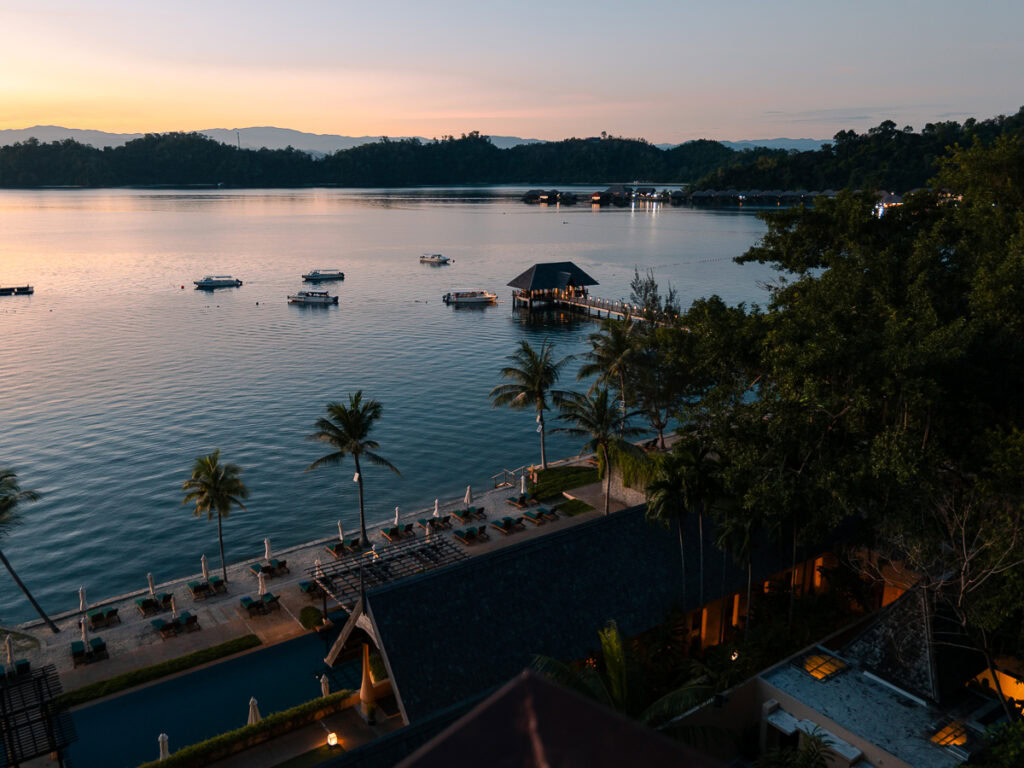
On my recent three month Southeast Asia trip I dedicated six weeks to exploring Malaysia, with a good chunk of that in Sabah, Malaysian Borneo.
I searched for (and found!) wild orangutans, watched proboscis monkeys play in the trees, met rehabilitated turtles at Borneo’s best eco-resort, and stayed at the world’s only dive rig. All of it was magic, and you can replicate my entire trip with this two week Sabah itinerary.
From river safaris and conservation projects to underwater adventures and tropical islands, here’s how to spend two weeks in Malaysian Borneo, plus helpful travel tips for where to stay, how to get around, what to pack and more.
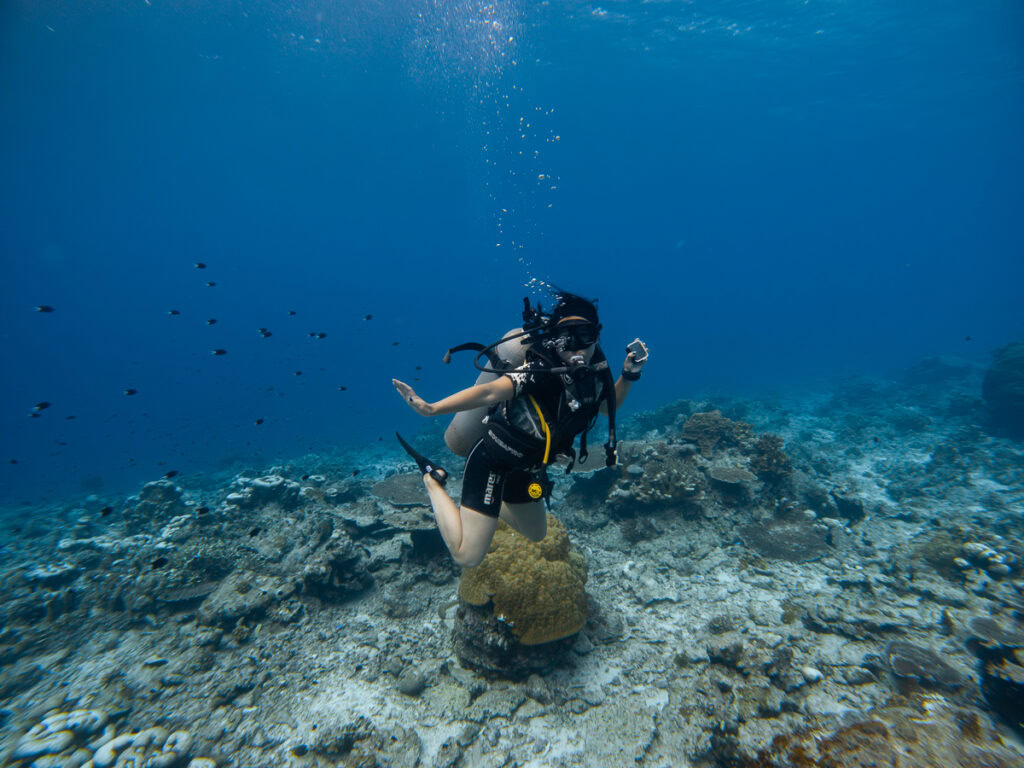
Table of Contents
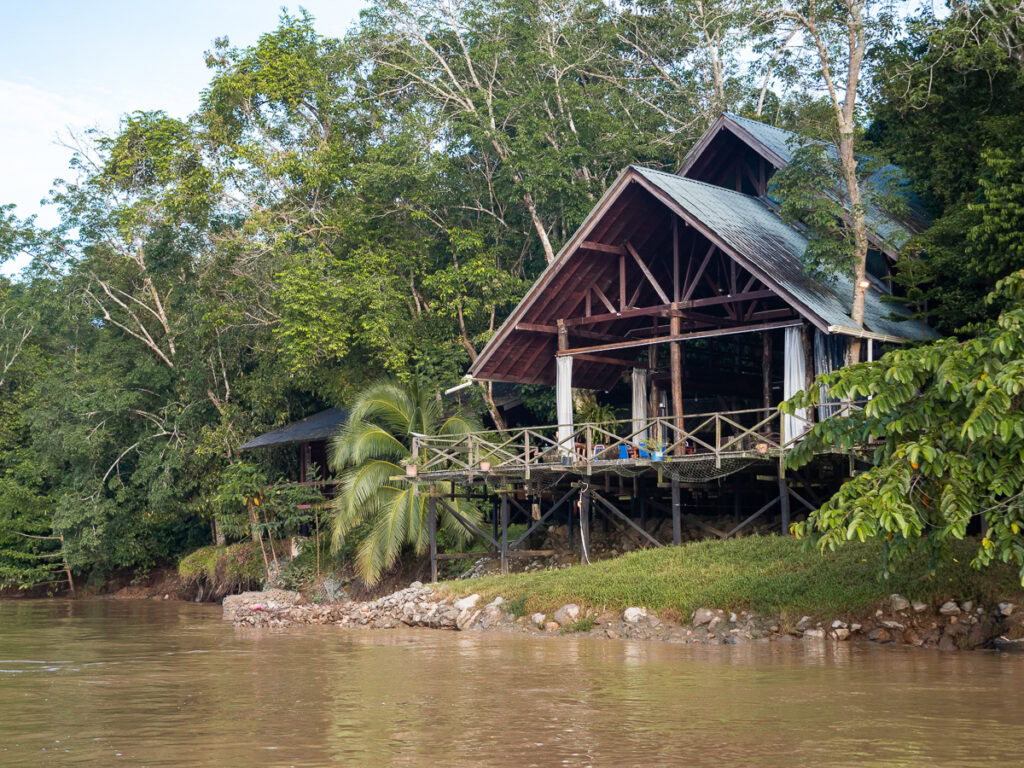
Quick summary: 2 week Borneo itinerary
This two week Borneo itinerary covers the following destinations in Sabah, Malaysian Borneo:
- Kota Kinabalu (often referred to as ‘KK’)
- Tunku Abdul Rahman Marine Park
- Kinabatangan River
- Sepilok
- Sandakan
- Semporna
- Sipadan
And if you’re keen to add on Kuala Lumpur and other Peninsular Malaysia hot spots, check out my ultimate three week Malaysia itinerary and my guide to solo travel in Kuala Lumpur.
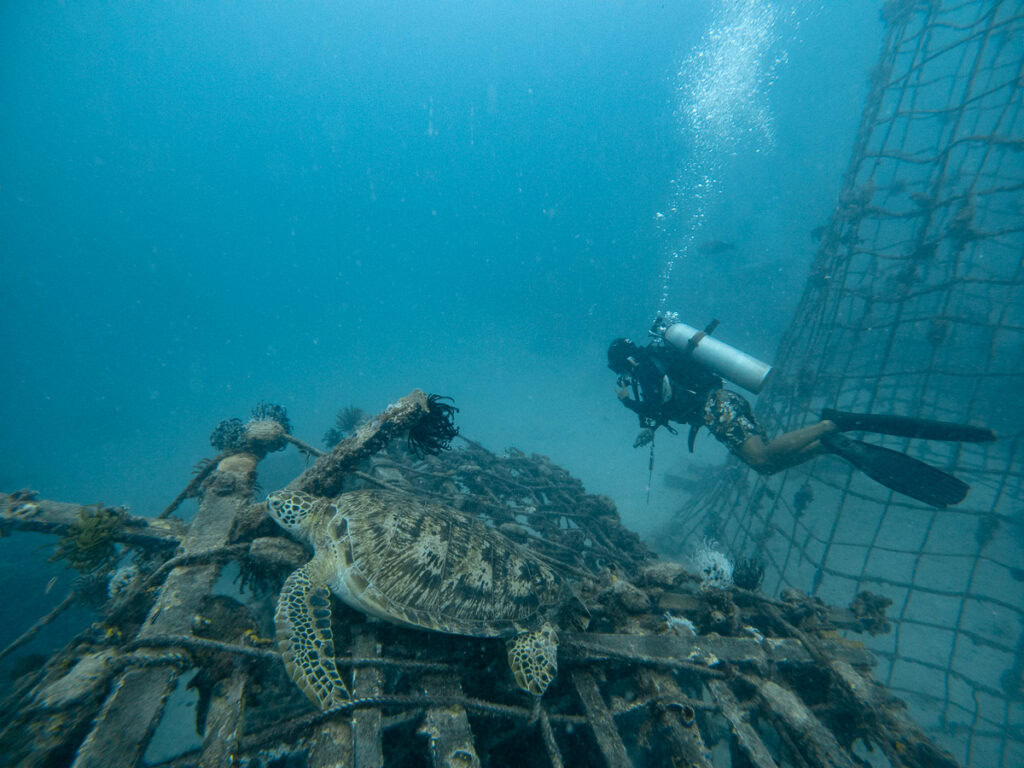
Borneo itinerary map
Things to know before your two weeks in Borneo
What country is Borneo in?
When I was in Borneo, I met multiple travellers who didn’t even realise Borneo wasn’t its own country until they went to book their flights, so don’t be embarrassed if you didn’t realise that until now!
Borneo is a massive island, and it’s actually split between three countries: Malaysia, Brunei and Indonesia.
The northern part of Borneo is Malaysia, split into two states called Sabah and Sarawak. The southern part of Borneo belongs to Indonesia, known as Kalimantan. The third country is Brunei, a tiny, independent coastal nation that’s surrounded by the Malaysian state of Sarawak.
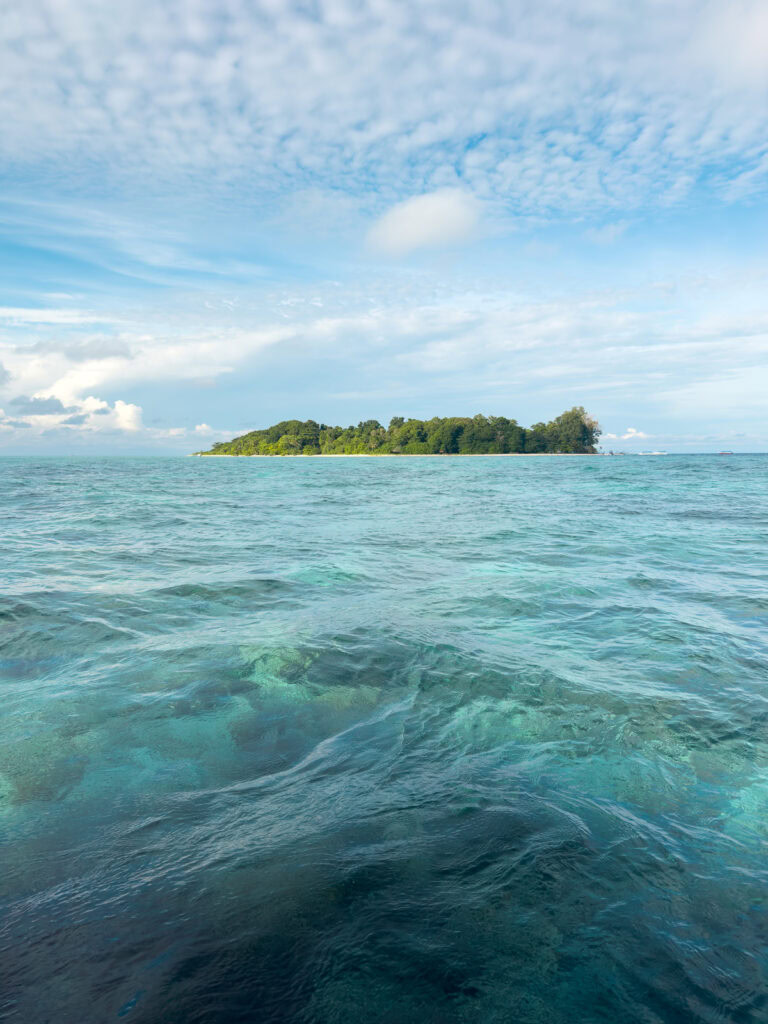
Where is Sabah?
Sabah is one of two states in Malaysian Borneo, and it covers the northern part of the island.
While it’s significantly smaller than Sarawak, Sabah is home to most of Malaysian Borneo’s most popular tourist destinations, and its infrastructure is more advanced and easier to navigate.
This two week Borneo itinerary sticks to Sabah, because it offers a diverse range of rainforest, island, underwater and cultural experiences that are easily explored in a fairly short timeframe, but if you’re lucky enough to have more time I’ve also mentioned a few bucket list spots in Sarawak at the end of the post.
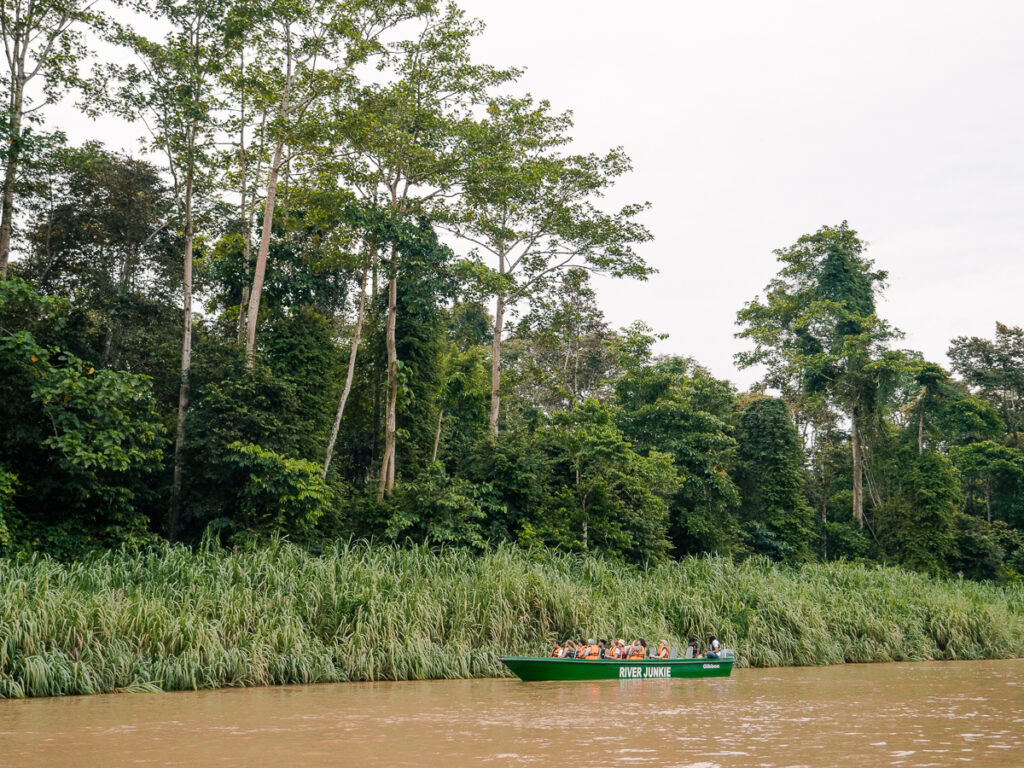
How to get to Borneo
✈️ You’ll need to fly to Kota Kinabalu to start this Sabah itinerary, unless you’re willing to spend days travelling by boat through the Indonesian islands and then even more days travelling overland from Kalimantan up to Sarawak and onto Sabah… Didn’t think so!
Kota Kinabalu International Airport (BKI) is well-connected with many major travel hubs in Southeast Asia, you can find direct flights from Kuala Lumpur from as low as $29USD one way on budget airlines like AirAsia. You can also fly direct from places like Singapore, Taipei, Seoul, Bali, Manila and more.
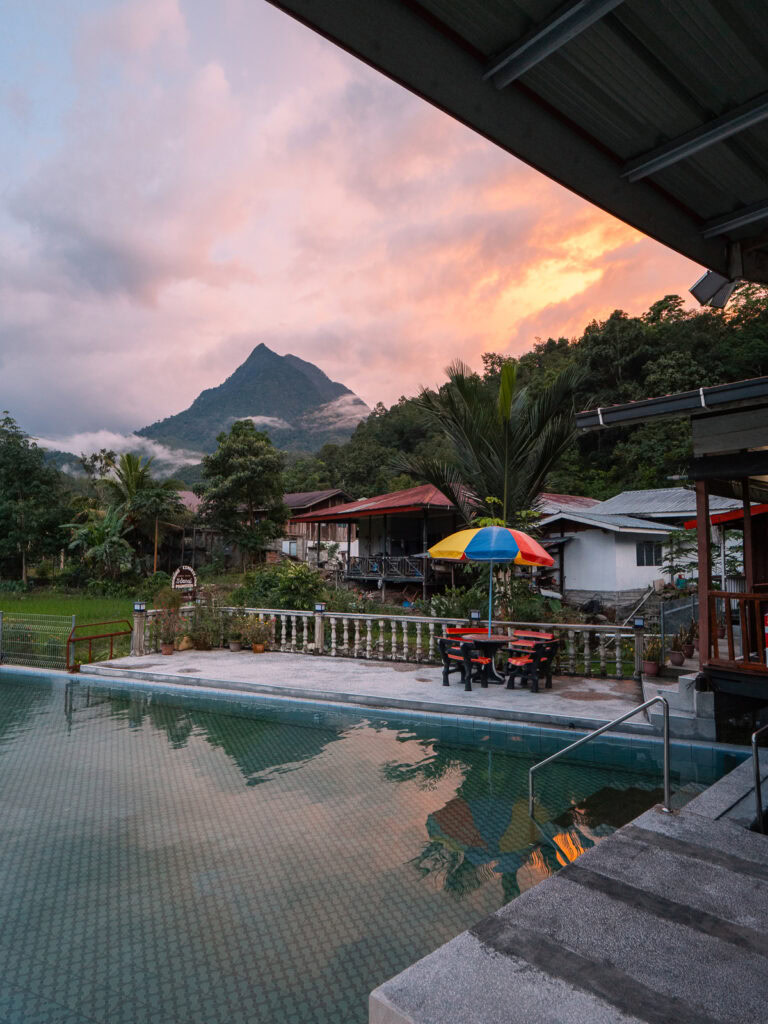
If you want to start this itinerary at a different point you can also fly into Sandakan Airport from Kuala Lumpur or other Malaysian cities, or Tawau Airport (near Semporna) from Peninsular Malaysia and a few international destinations.
I use Skyscanner to find cheap flights, and then I always book direct with the airline.
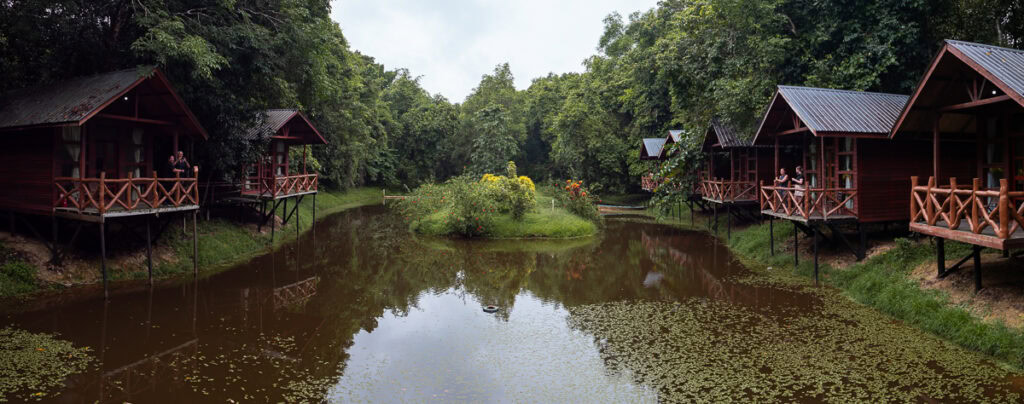
How to get around Borneo
Getting around Borneo can be tricky, because their public transport infrastructure isn’t as developed or reliable as you’d find in Peninsular Malaysia or more popular tourism destinations in Southeast Asia. For this itinerary, I recommend a combination of the following transport options 👇🏼
🚐 Group tours
If you’re looking for low effort and maximum reward, booking an organised tour to cover the main spots of Kinabatangan River, Sepilok and Sandakan/Turtle Island is going to significantly reduce your planning time, and probably save you money too.
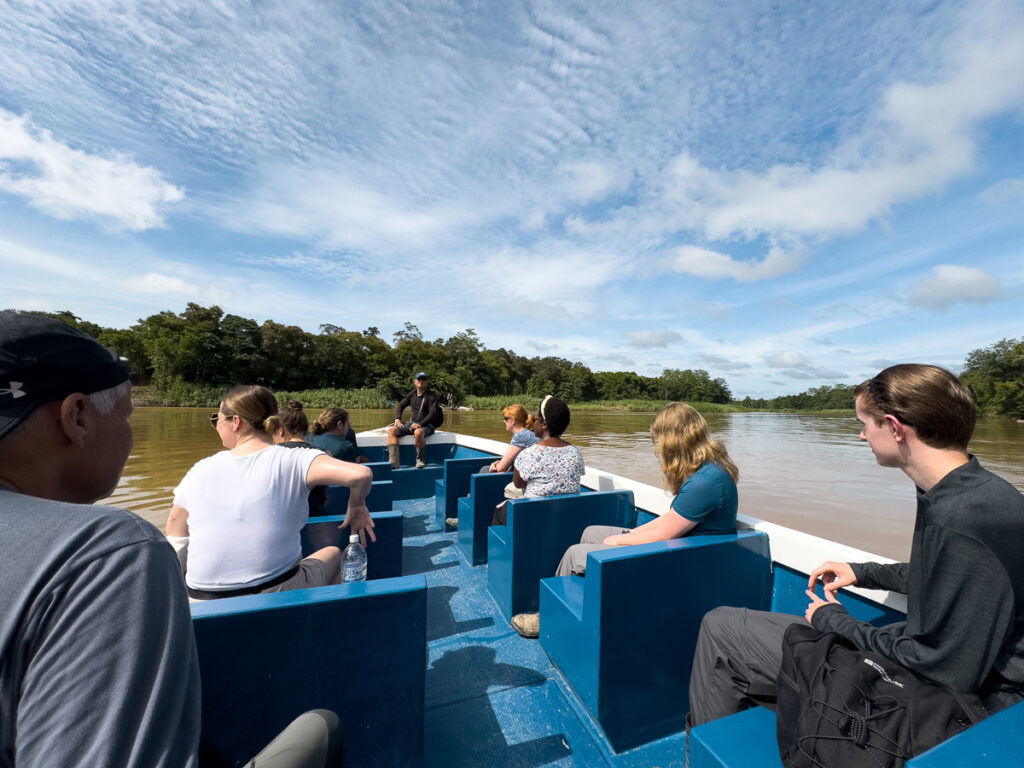
I booked the top-rated East Sabah Adventure wildlife tour with G Adventures and it was ideal, eight days with a legendary wildlife-spotting guide and a like-minded crew of 15 travellers, without having to piece together local buses or spending time researching the must-sees in each place. Perfect for solo travellers!
You can also book shorter group tours to visit Kinabatangan River and/or Sepilok from Sandakan for three or four days, like this top-rated one on Klook (save 10% with the promocode FINDINGALEXXKLOOK), but most of these have single supplements.
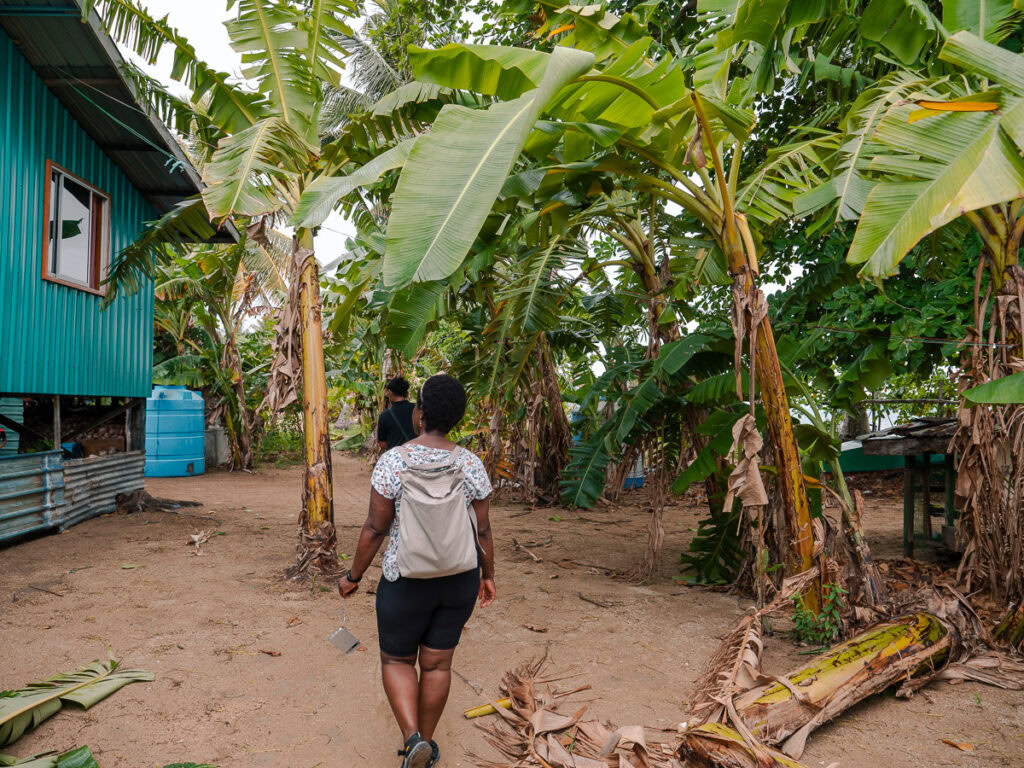
🚌 Public transport
There are cheap buses that connect major spots like Kota Kinabalu, Sandakan and Semporna if you don’t mind a long trip, the most popular bus routes are:
- Kota Kinabalu to Sandakan, 7h 30m
- Kota Kinabalu to Semporna. 11h 30m
- Sandakan to Semporna, 6h
To reach more remote places like Kinabatangan River you’ll need to book a taxi or organised tour from Sandakan, these aren’t serviced by buses.
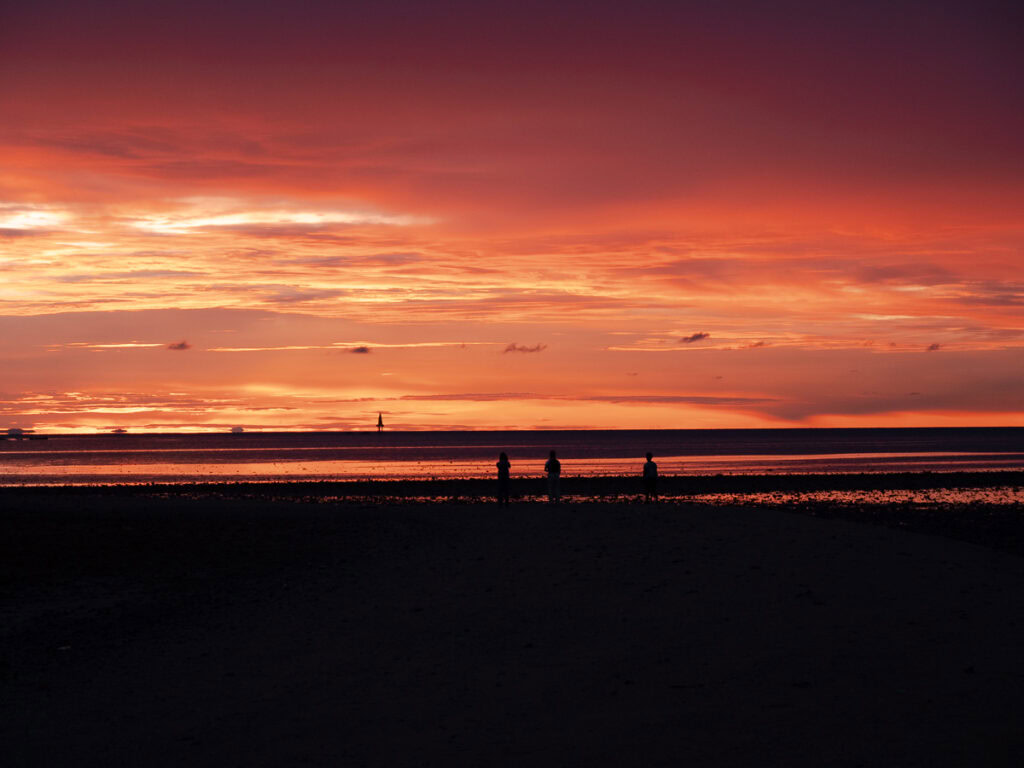
I met a few travellers in Borneo who were getting around by bus, and their main feedback / warning was that catching a bus from along the route (e.g. from a lodge outside of Sandakan rather than getting on in Sandakan at the start of the bus trip) can be very difficult to organise, so it’s best to take the whole journey and connect using taxis or Grab to your final spot.
One solo traveller was telling me how she had to wait on the side of the road in an area with no phone coverage, no rain shelter, no seat, and no actual time that the bus would arrive, just that it should be there at a rough time, give or take an hour, aaaand it started raining. No thank you 🙃
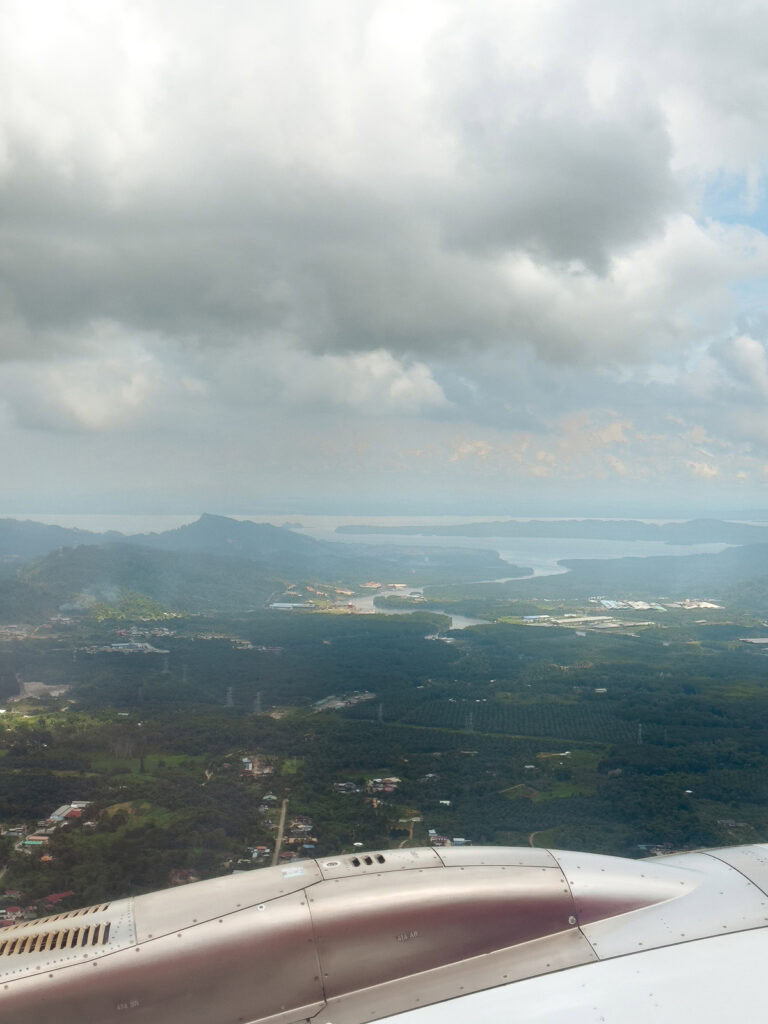
🚗 Taxis/Grab/private drivers
Grab is the main Southeast Asian ride-hailing app (like Uber) and it’s super cheap and easy to use for short distances, like around Kota Kinabalu, between Sandakan and Sepilok, or to get from Tawau Airport to Semporna.
For longer trips between KK and the jungle or northern coast, you can book private drivers that are fairly affordable compared to other countries but still much pricier than a group tour.
✈️ Domestic flights
To cover the long distances between Kota Kinabalu, Sandakan and Tawau (for Semporna/Sipadan), there are super cheap domestic flights.
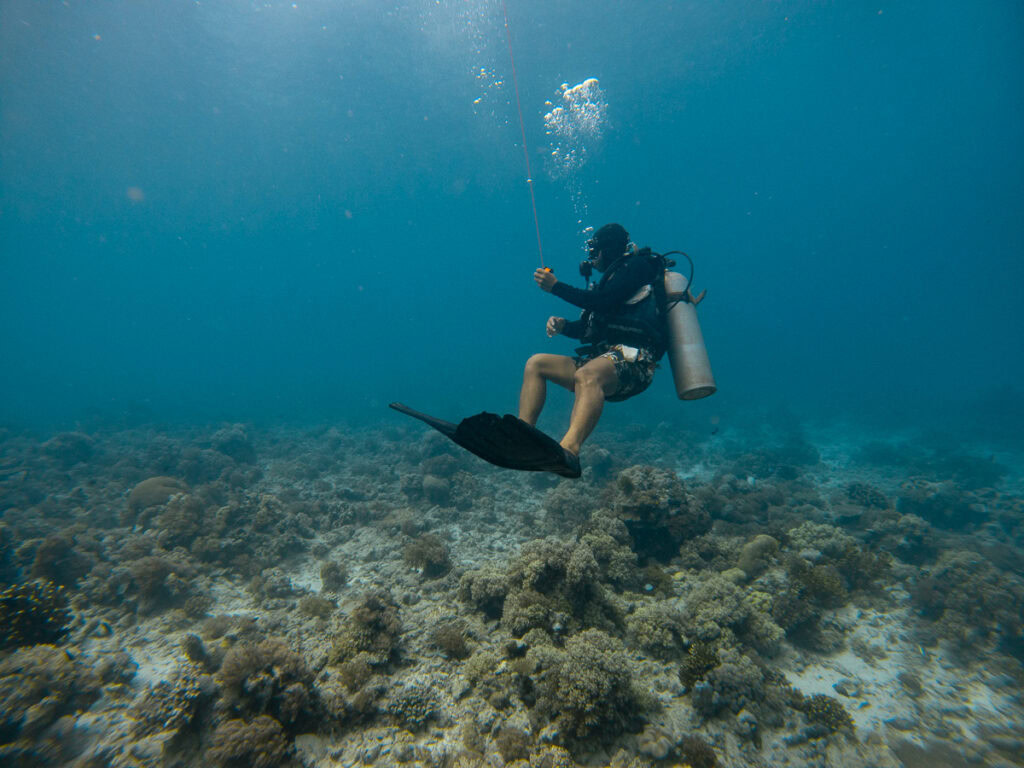
When is the best time to visit Borneo?
Borneo is a true year-round destination, with wildlife able to be spotted throughout both seasons, but the perfect time for your trip will depend on your priorities.
It’s also important to note that as a tropical destination, Borneo’s weather can be very changeable, and storms can hit at any time of the year. I was here in June, the middle of dry season, and Sabah had just been hit by days of torrential downpours which caused flooding throughout the state.
🌞 Dry season (March to October): This is the best time to visit if you want to maximise your chances of good weather, ideal for jungle trekking, wildlife spotting and scuba diving, with less rain and clearer skies. It’s also the busiest time for tourism though, particularly July and August, so book early if you’re planning to visit in these months.
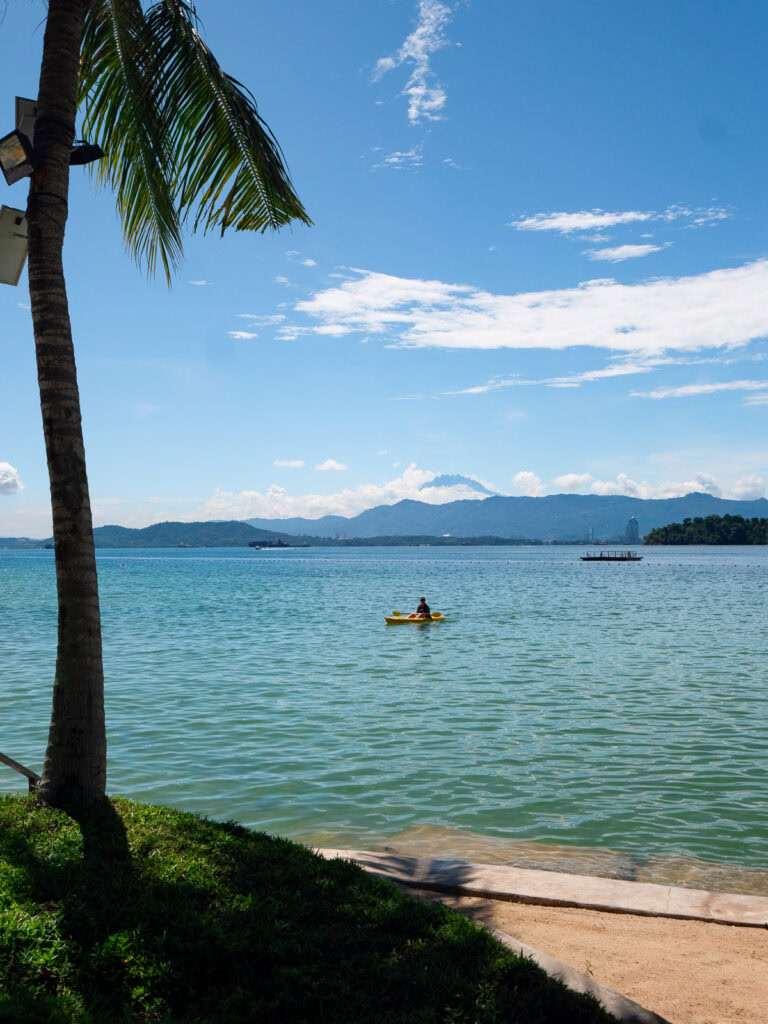
🌧️ Wet season (November to February): The coastal areas and rainforest typically receive heavy rains in the wet season, which can impact some activities, but the upside is that there are fewer tourists, lush landscapes and lower prices. Just be sure to pack decent wet weather gear! If you’re planning on diving, keep in mind that Sipadan closes for a month each year for conservation purposes, this is usually November.
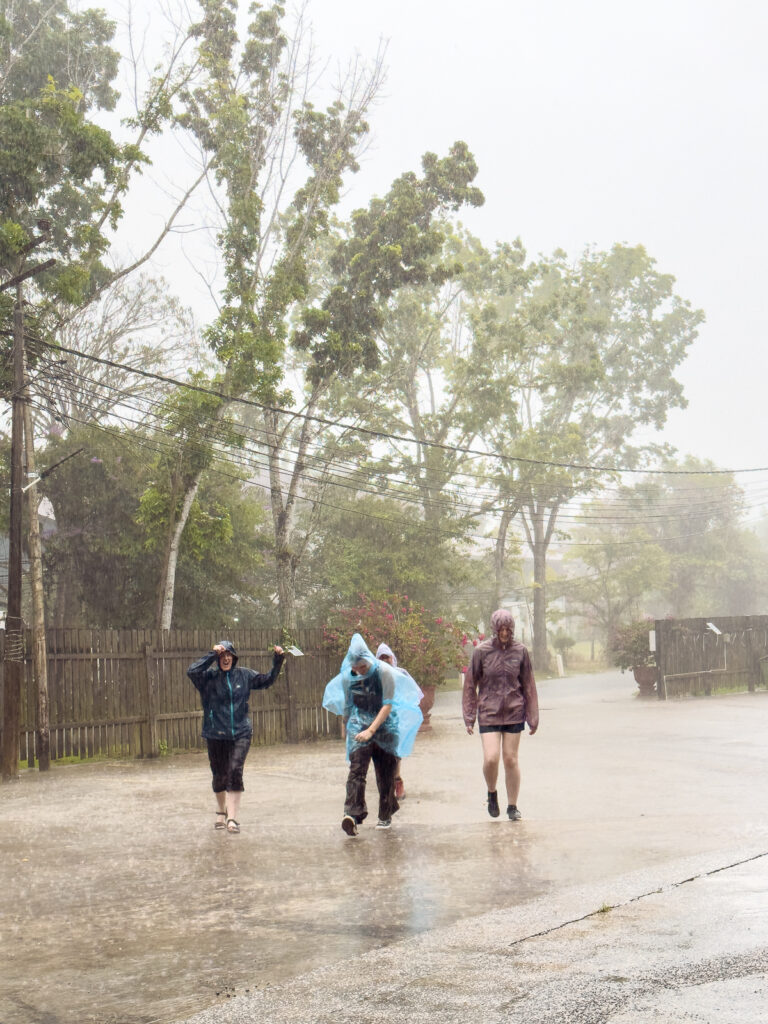
How much to budget for this Borneo itinerary
🛌 Accommodation: You can find hostel dorm accommodation from $5-15USD per night, budget hotels or guesthouses from $15-30USD, and nicer apartments or 4* hotels from $30-50USD. Top-rated 5* hotels start from about $120USD (great value for money if you have the budget for it). Expect to pay more for remote stays like island resorts or jungle lodges.
🚐 Transport: Domestic flights can cost as little as $20USD if you book in advance, but you’ll need to add checked luggage if you have a suitcase. Public buses are super cheap, around $5-15USD for the long routes, and private drivers typically cost $50-$90USD per day depending on the type of car you want.
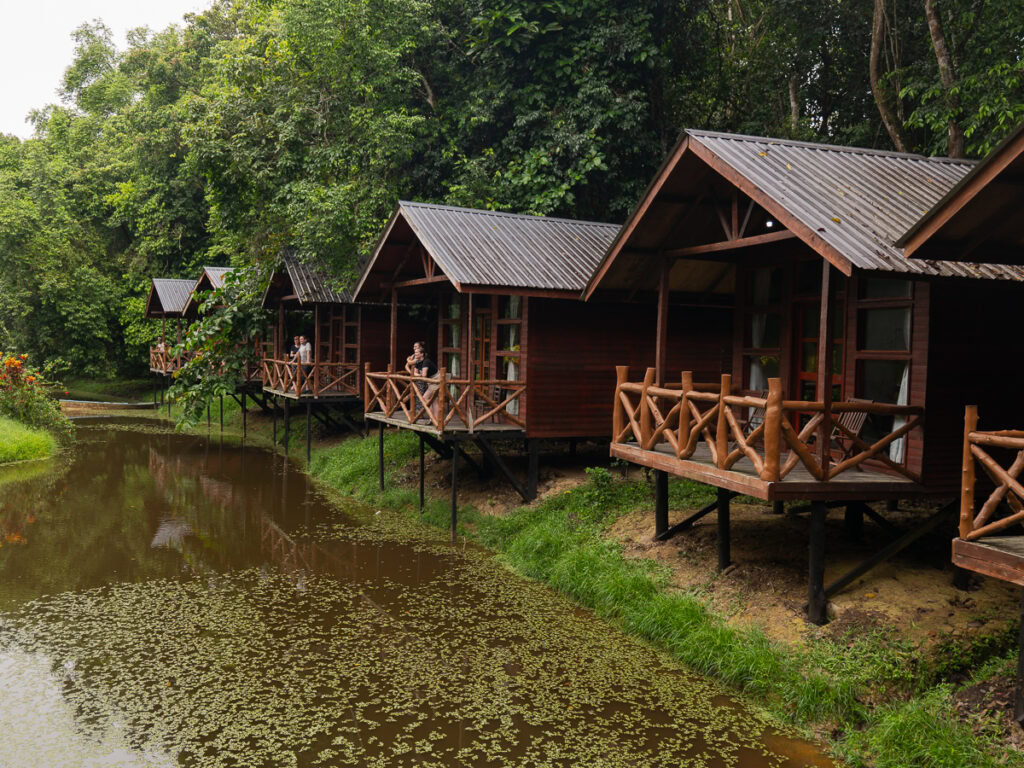
🍜 Food: You can easily eat for $10-20USD per day if you stick to street food, local restaurants and markets, but touristy areas like KK’s waterfront or Sepilok will be more like $10-15USD per meal. Many tours include meals as you might stay at homestays or jungle lodges, so check this before you book to get a better idea of budget.
🎟️ Activities: Guided day tours like snorkelling trips, firefly river cruises or city tours typically range from $30-70USD, multi-night tours start from about $80USD per night but go up to $300 per night depending on the level of comfort and inclusions you get. The tour I did, the East Sabah Adventure with G Adventures, starts from about $165USD per night but that includes accomm, all transport, lots of meals, and all wildlife experiences.
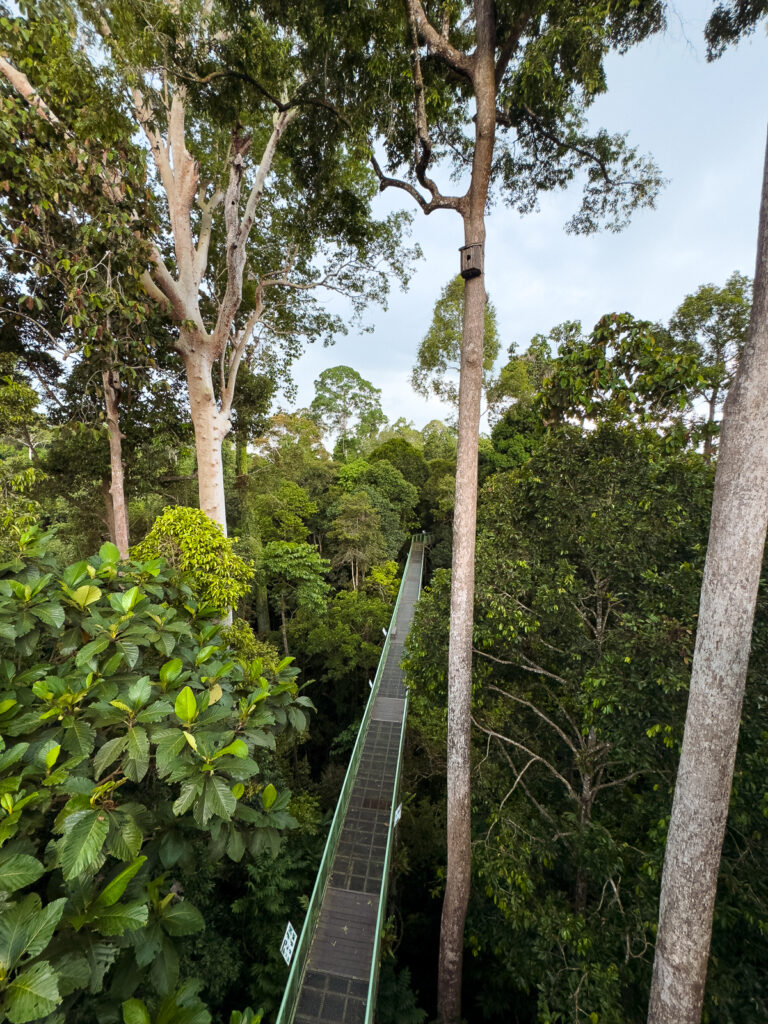
The ultimate two week Borneo itinerary
Who is this Borneo itinerary for?
This itinerary for Sabah, Borneo is for travellers who are keen to see the major wildlife highlights and split their time between jungle and coast, along the main tourist routes that are accessible without blowing your budget. It includes a few long travel days but nothing too intense.
It doesn’t cover the Mount Kinabalu hike (but you could easily add that on), anything too remote, or any other parts of Borneo (Sarawak, Brunei or Kalimantan), but I’ve included those as potential extensions at the end.

Kota Kinabalu
How to get to Kota Kinabalu: Kota Kinabalu is the capital of Sabah and the gateway to Malaysian Borneo, serviced by loads of direct flights from Kuala Lumpur and other hubs in Peninsular Malaysia, Singapore, Vietnam, South Korea, Indonesia and more.
How long to stay: 1-2 days
About Kota Kinabalu
Kota Kinabalu (known locally as ‘KK) is your laidback entry point to your Borneo adventure, a bustling hub with the perfect mix of city conveniences (hellooooo giant shopping malls) as well as easy access to nature, both land and sea.
I personally think the best parts of Borneo sit outside of the capital, but it’s worth spending a day or two here to indulge in local cuisine at the night markets, see the famous Floating Mosque and stock up on anything you need before you set off on your adventure.
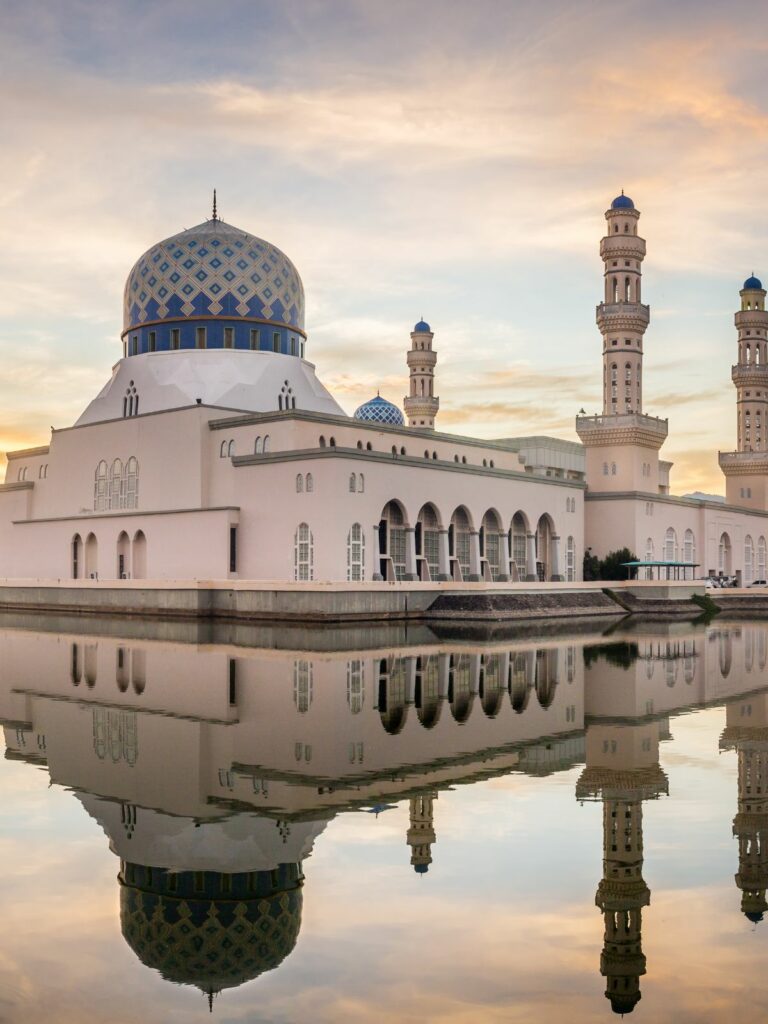
Things to do in Kota Kinabalu
- Wander the waterfront at sunset, then eat your way around the night markets
- Admire the Floating Mosque, best visited on a perfectly still day where the mosque is mirrored in the water that surrounds it
- Head to the Sabah State Museum to get an insight into local culture and traditions
- Take a day trip to Mari Mari Cultural Village for an authentic indigenous experience
- Visit Mount Kinabalu Park for a day hike through lush rainforest trails
- Feast on freshly-caught seafood, we went to KK Garden Seafood and ‘feast’ is the only way to describe it!
- Join a mangrove river cruise to see fireflies
- Hike to the summit of Mount Kinabalu (2-3 days), save 10% on this tour with the promocode FINDINGALEXXKLOOK
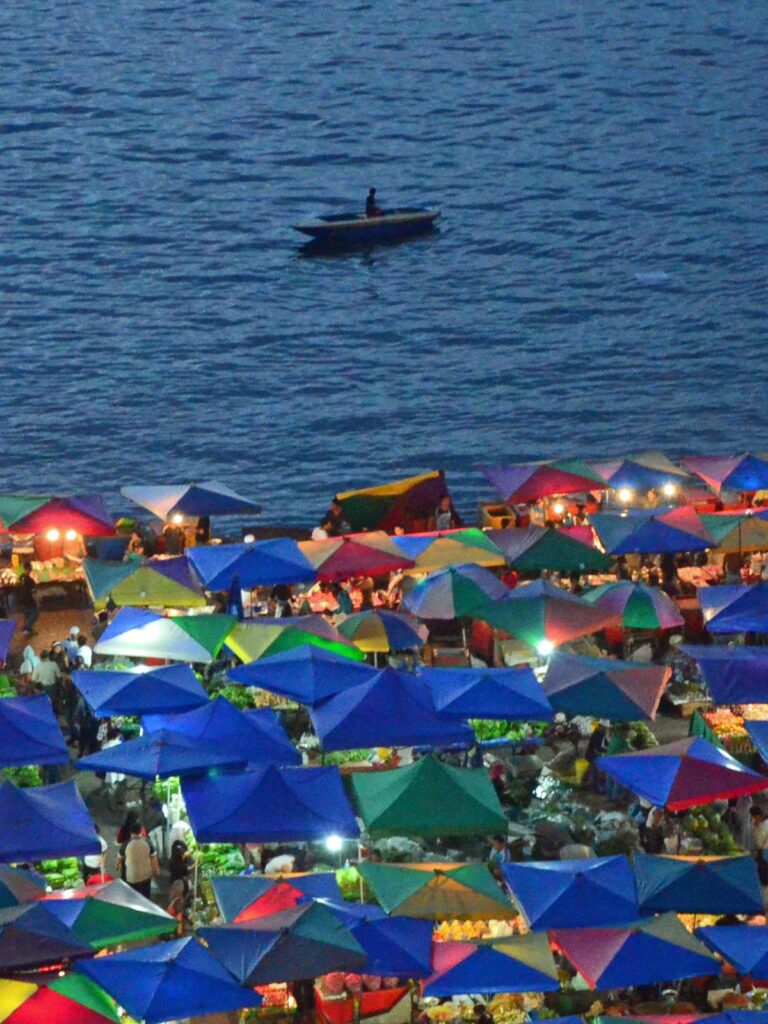
Where to stay in Kota Kinabalu
Budget:
- TOOJOU Hostel is my top pick for digital nomads! They’ve got dorms plus private rooms, a dedicated co-working space, a rooftop bar, a slide to get from one floor to the reception, a hostel cat named Pablo, and Pablo SLIDES DOWN THE SLIDE. Seriously, I have proof. This is reason alone to stay at TOOJOU!
- H2 Worldpackers (social hostel, cheap and cheerful)
- ACJ Residence (cosy and stylish budget private rooms)
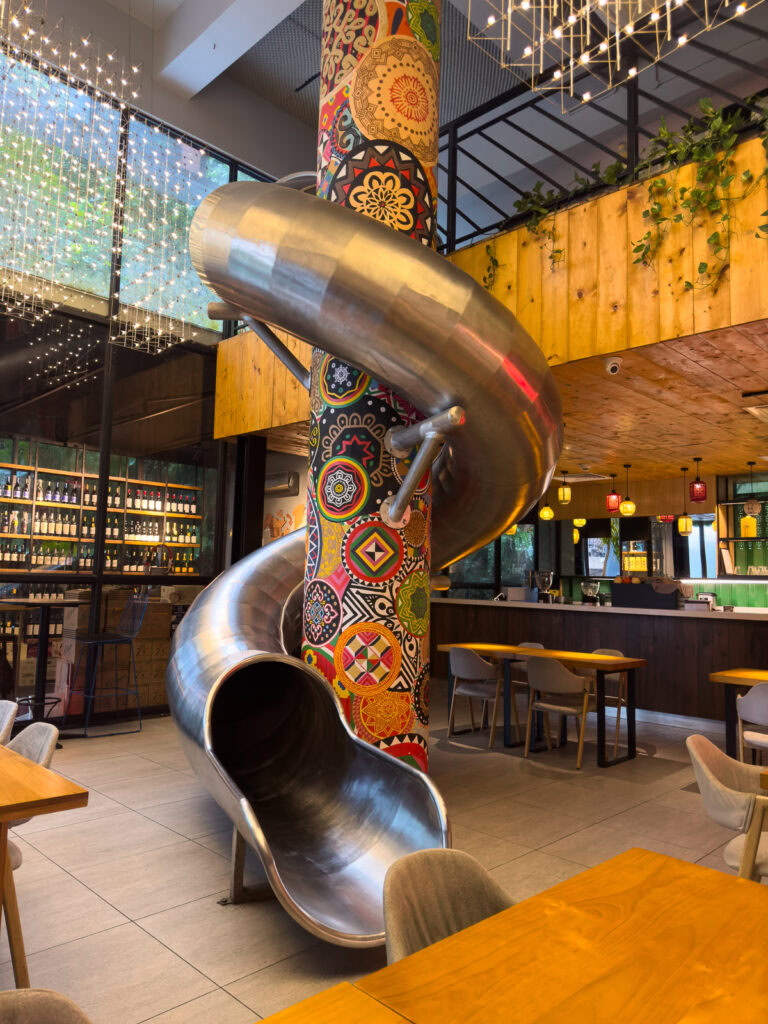
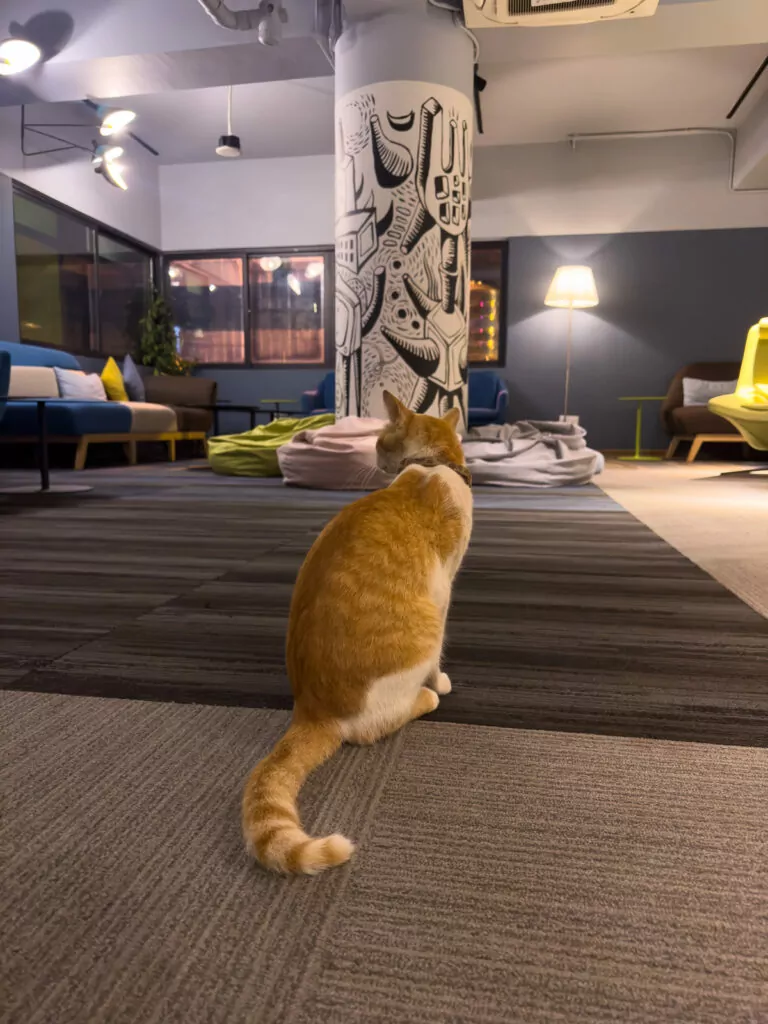
Mid-range:
- The LUMA Hotel (stunning boutique design hotel in the photos below, I stayed one night and it wasn’t enough!)
- Hotel 7 Suria (simple but ideal location next to the port, and super affordable)
- The Aru Hotel (studios and apartments away from the crowds with a dreamy infinity pool)
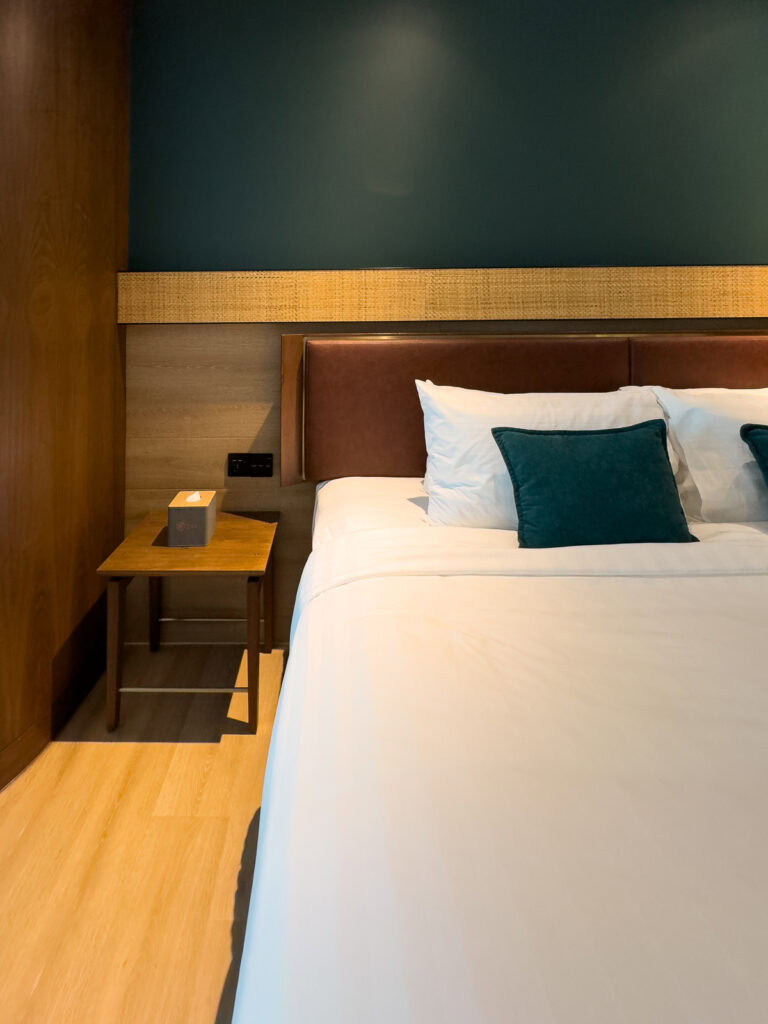
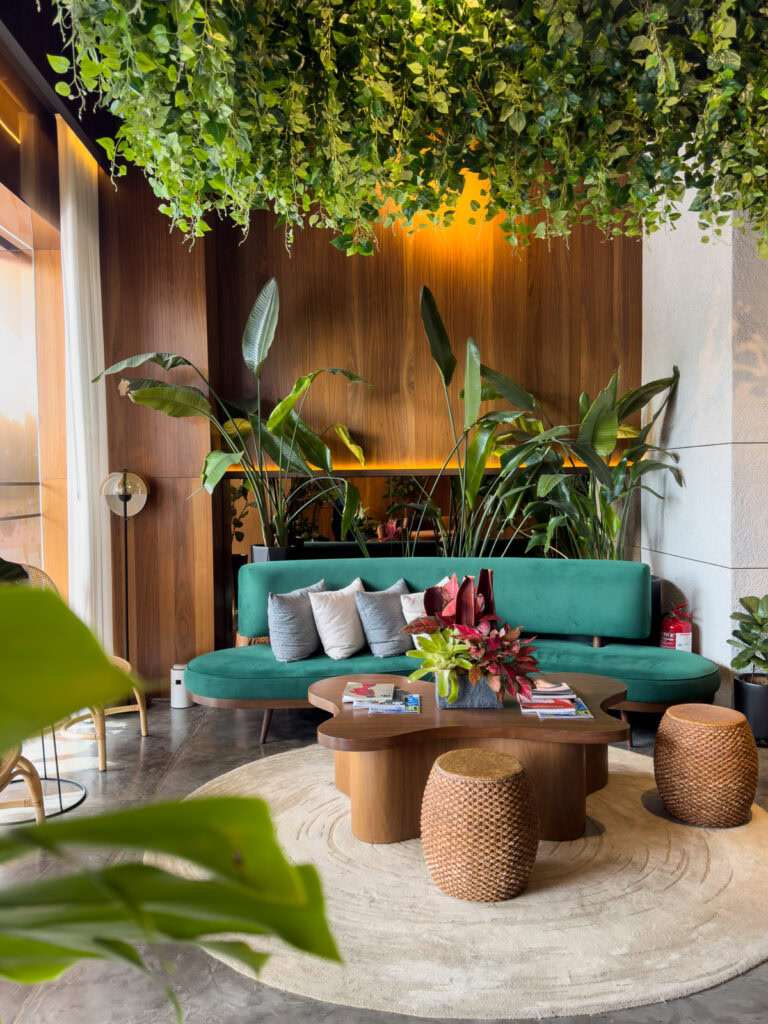
Luxury:
- Le Meridien (5* waterfront luxury hotel, good value)
- Hyatt Centric (super stylish and new 5* hotel with a rooftop swimming pool)
- Ritz Residence (fancy, opulent hotel rooms in the Imago shopping complex)
- Shangri-La Tanjung Aru (top-rated 5* beachfront resort)
Tunku Abdul Rahman Marine Park
How to get to Tunku Abdul Rahman Marine Park: Super easy from Kota Kinabalu, just head to Jesselton Point Ferry Terminal and there are regular day trips and transfers to the island hotels.
How long to stay: Day trip if that’s enough for you, but 1-2 nights at one of the resorts is well worth it if you have time, and gives you the chance to see nocturnal animals
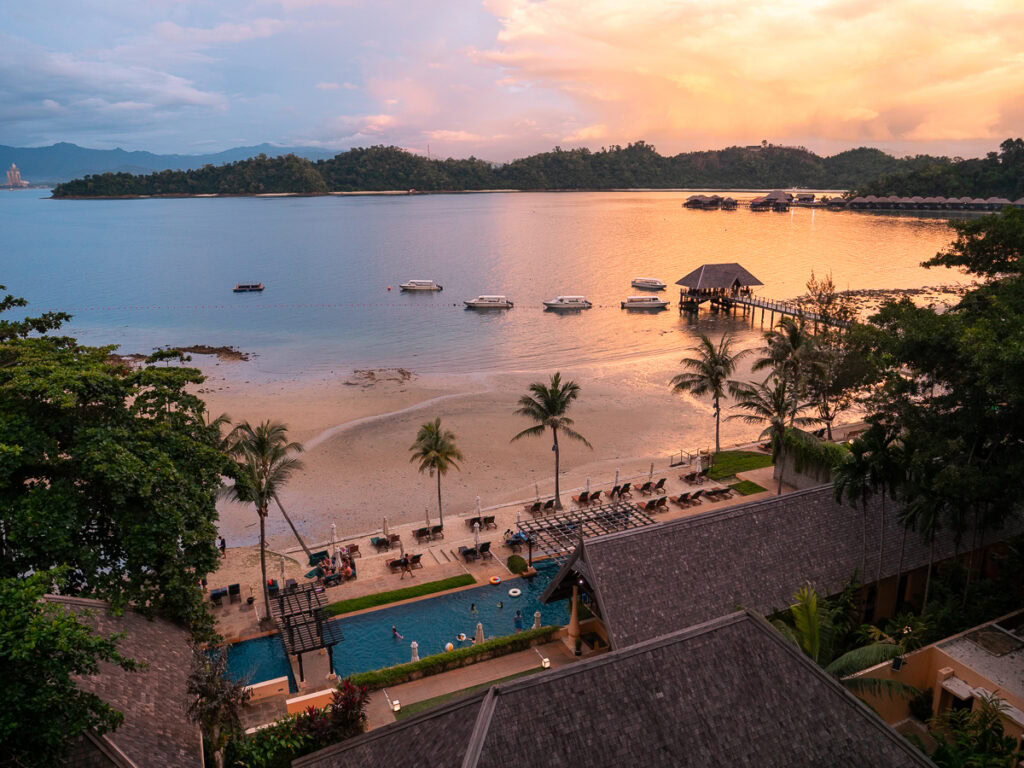
About Tunku Abdul Rahman Marine Park
The jewel in KK’s tourism crown, the Tunku Abdul Rahman Marine Park is a group of five islands just a short boat ride from the city, a must-visit for anyone with a love for the water.
It’s a conservation area and national park, with about 50km² of protected sea and coral reefs that are home to rich and diverse marine life, including sea turtles, reef sharks, cuttlefish, octopus, nudibranch and loads more.
And above water there are creatures to find too, you’ll see monkeys swinging between the trees, hornbills flying above you, and if you’re super lucky you might even spot the critically endangered pangolin if you’re doing a night walk at a resort.
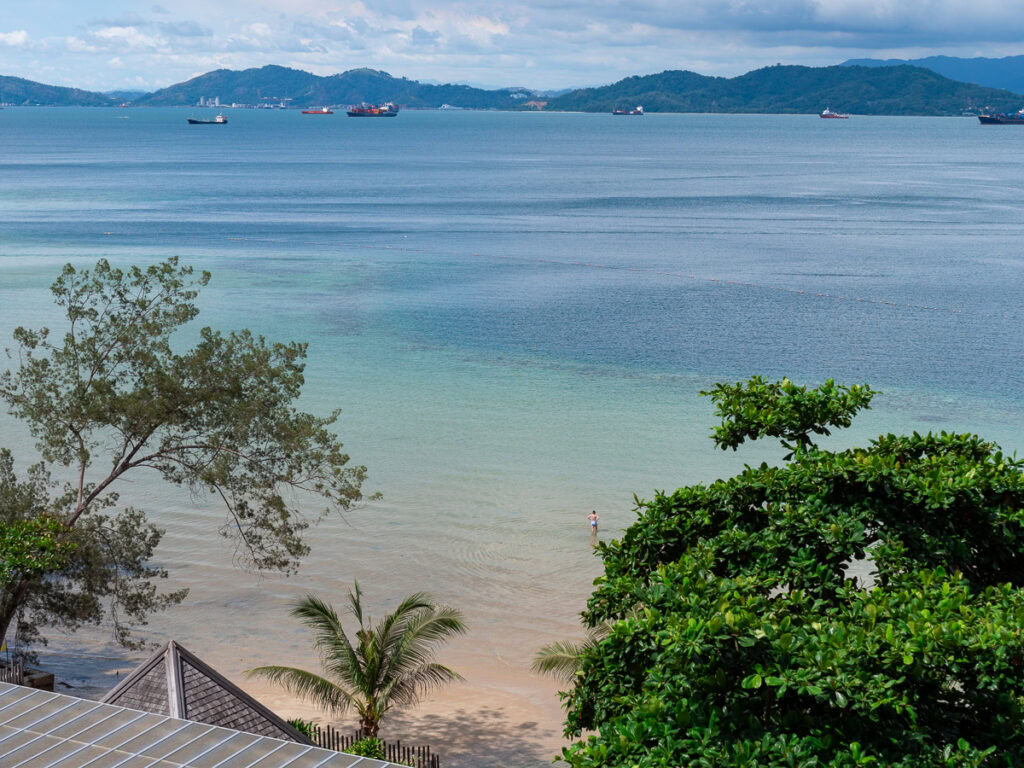
Best day trips for Tunku Abdul Rahman Marine Park
P.S. You can save 10% off all of these day trips (and most other Malaysia experiences!) on Klook with the promocode FINDINGALEXXKLOOK. You’re welcome!
- This affordable island hopping tour that visits both Manukan and Sapi islands for snorkelling and beach time
- This premium catamaran snorkelling tour for a more comfortable ride
- This party boat day cruise or sunset cruise if that’s more your kind of vibe
- This guided PADI snorkelling experience if you want the safety of swimming with an instructor
- Or go scuba diving! You can book a beginner dive trip if you’re brand new, do your PADI Open Water course if you’d like to get certified, or just book some leisure dives if you already have your license.
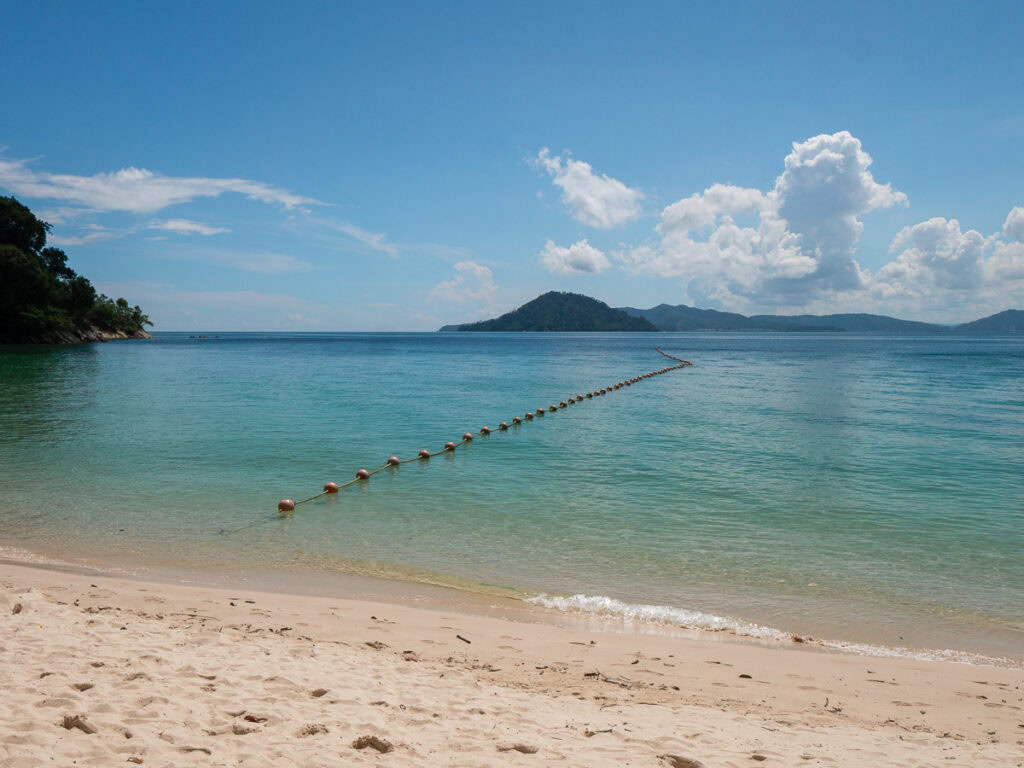
Staying overnight Tunku Abdul Rahman Marine Park
If you’d like to spend more time exploring the marine park to meet its land animals or get more time underwater, or just want to treat yourself to a lush island getaway, staying a night or two at one of the island hotels is a worthy addition to your Sabah itinerary.
My recommendation would be to stay at Gaya Island Resort, a luxury eco-resort with villas perched amongst the rainforest overlooking the ocean and Mount Kinabalu in the distance. Seriously, look at this view!
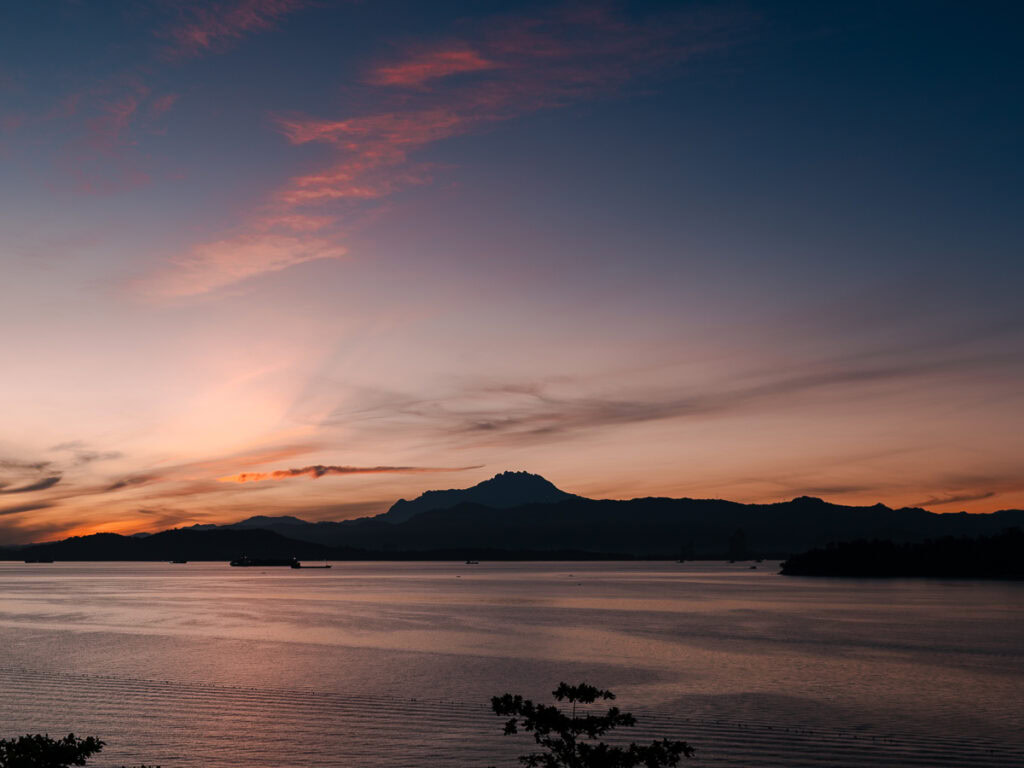
The rooms are huge and comfortable, there’s a range of dining options from the classic buffet to teppanyaki, seafood feasts or traditional indigenous culinary experiences, they have an award-winning spa, and the service is absolutely world-class.
But what I love the most about Gaya Island Resort is that they are all about sustainability and conservation, and they truly walk the talk!
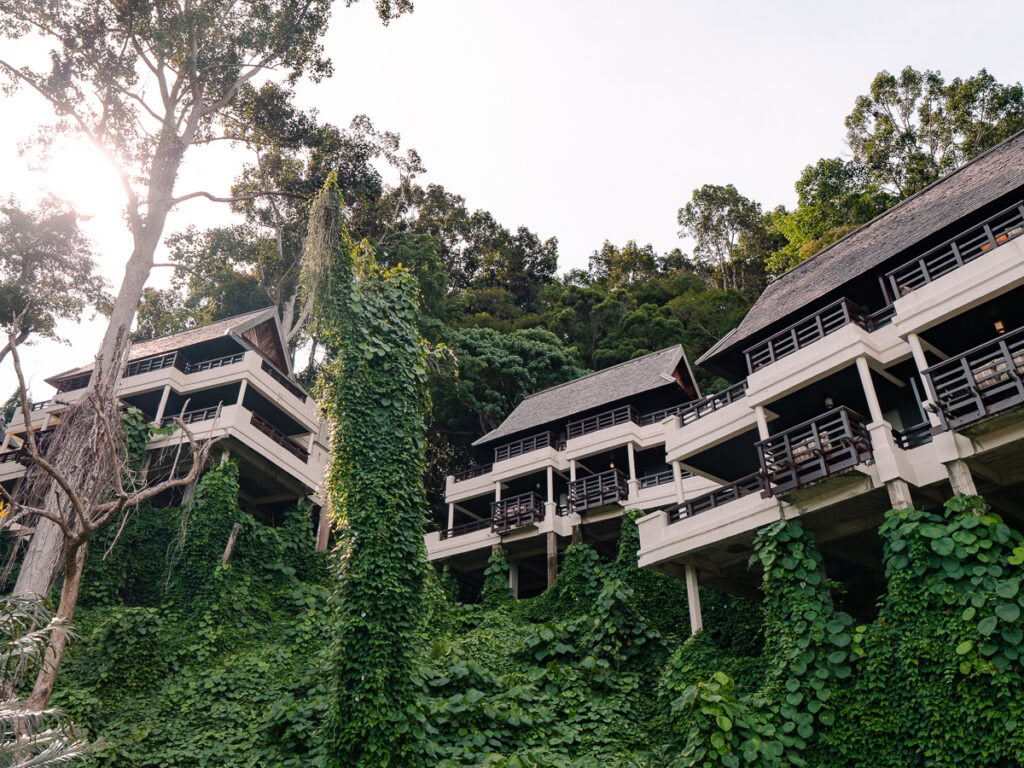
They have an in-house conservation team of marine biologists and ecologists who are committed to protecting the island’s ecosystem, giving guests the chance to partake in coral restoration, guided snorkelling trips and jungle walks, educational talks at the wildlife centre, or even meet the resort’s rescued turtles if they have any that are currently being rehabilitated before their release back into the wild.
One of my favourite island resorts in the world 💚
Other resorts in the marine park are:
- Bunga Raya Island Resort (Gaya Island)
- Gayana Marine Resort (Gaya Island)
- Sutera Sanctuary Lodges (Manukan Island)
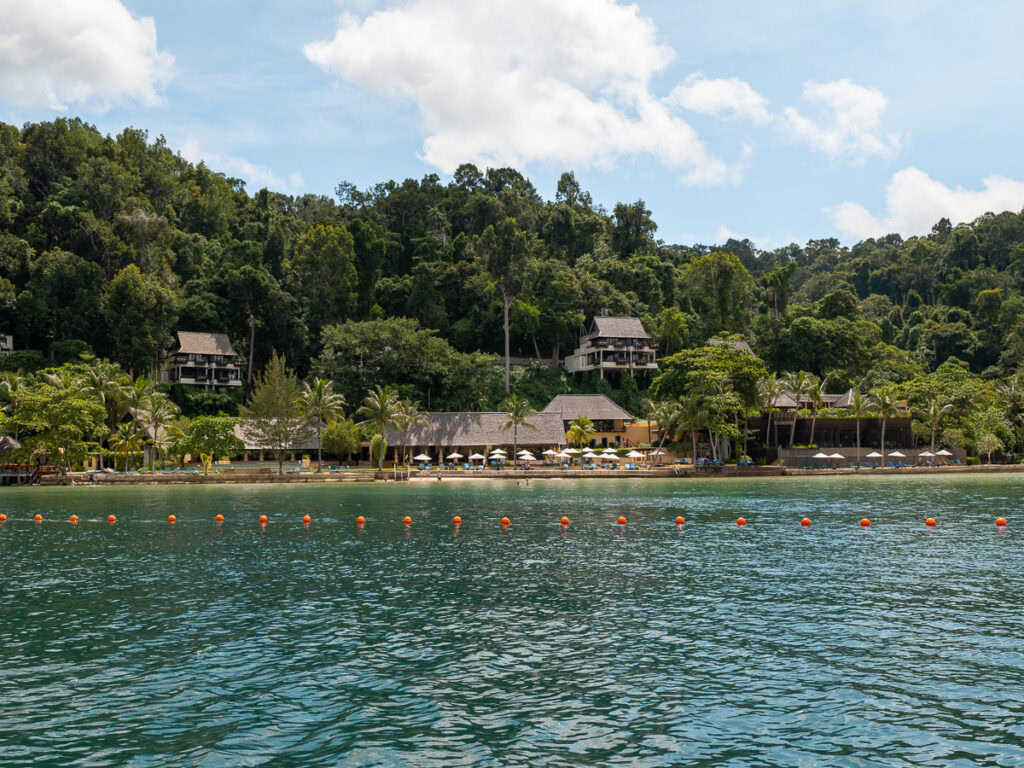
Kinabatangan River
How to get to Kinabatangan River: It’s about 5-6 hours from KK if you’re driving, or if you fly to Sandakan it’s a 2-3 hour drive from there
How long to stay: 2-3 days gives you enough time for multiple river safaris and night walks, maximising your chance to see weird and wonderful creatures
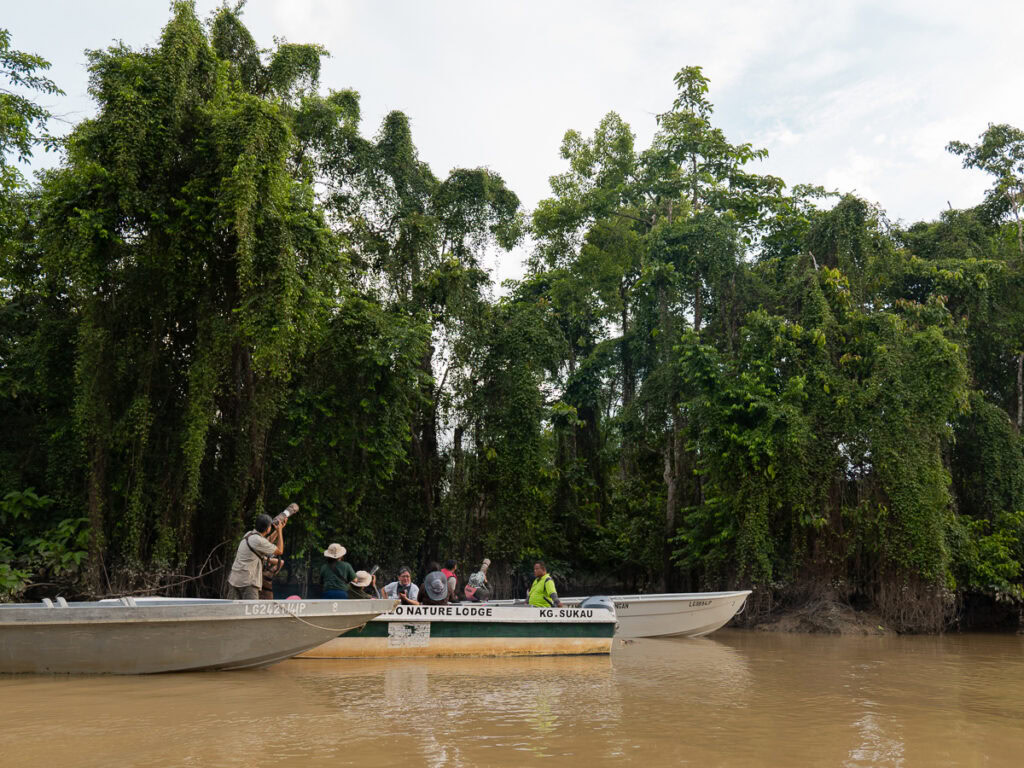
About Kinabatangan River
If you’re here for the wildlife or if you’re a keen animal photographer, Kinabatangan River is probably going to be the highlight of your two weeks in Sabah!
Winding over 560km through Sabah’s wilderness, this jungle-flanked waterway offers easy access to get up close and personal with one of the most unique ecosystems on the planet. Simply jump on a river safari and keep your eyes peeled, and you might be lucky enough to spot proboscis monkeys, pygmy elephants, orangutans, crocodiles and more.
For the ultimate Kinabatangan River experience I’d recommend booking a tour that includes an expert wildlife guide (like my G Adventures Borneo tour), or if you’re short on time this 4D3N wildlife tour from Sandakan has great reviews.
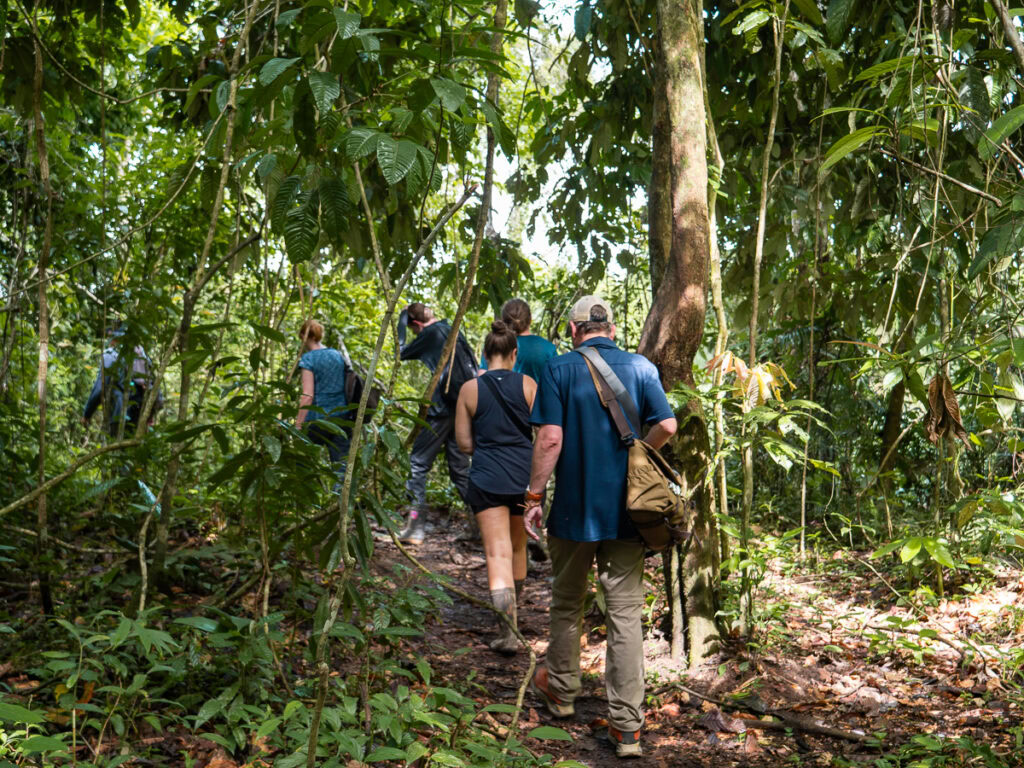
Things to do in Kinabatangan River
- A river safari! This is the absolute must-do in Kinabatangan River, giving you a floating front row seat to spot rare wildlife in their natural habitat
- Jungle trekking, many lodges offer guided treks through the trees to learn about local flora and fauna, and potentially see some animals even closer than if you were on a boat
- Go for a guided night walk from your lodge to see night-dwellers, like tarsiers, owls, fireflies, tree frogs and more
- Get ‘I Just Can’t Wait to be King’ from the Lion King stuck in your head for hours every time you see a hornbill (“Kings don’t need advice from little hornbills for a staaaaart”, “If this is where the monarchy is headed COUNT ME OUT, out of service, out of Africa, I wouldn’t hang about”
- Realise while on the river cruise (three decades after Lion King came out) that when Zazu says “this child is getting wildly out of wing” it’s like he’s saying out of hand but he says WING because he’s a BIRD 🤯 brilliant lyricism
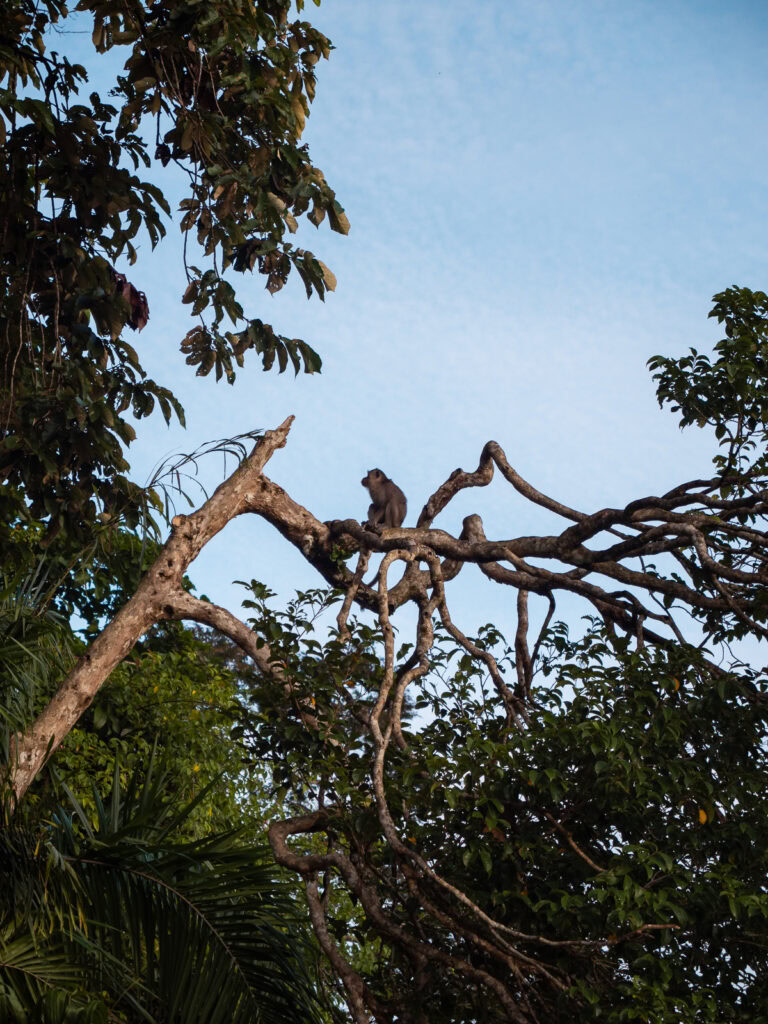
Where to stay in Kinabatangan River
The lodges along Kinabatangan River are mainly concentrated in the Bilit and Sukau areas. If you’re travelling independently (without a tour) then you can book full-board packages at these eco-lodges:
- Borneo Natural Sukau Bilit Resort is where I stayed on my tour, it has basic jungle huts with proper bathrooms, buffet for every meal (nothing special but it was okay!), morning and afternoon river safaris + night walks available too
- Bilit Adventure Lodge is a slightly more upmarket option
- Borneo Jungle Adventure also has great reviews
- Sukau Rainforest Lodge is more luxurious

Sepilok
How to get to Sepilok: From the lodges in Bilit and Sukau, Sepilok is about 1h 45m by car, or if you’re coming from Sandakan it’s only 20-25 minutes
How long to stay: 1-2 days
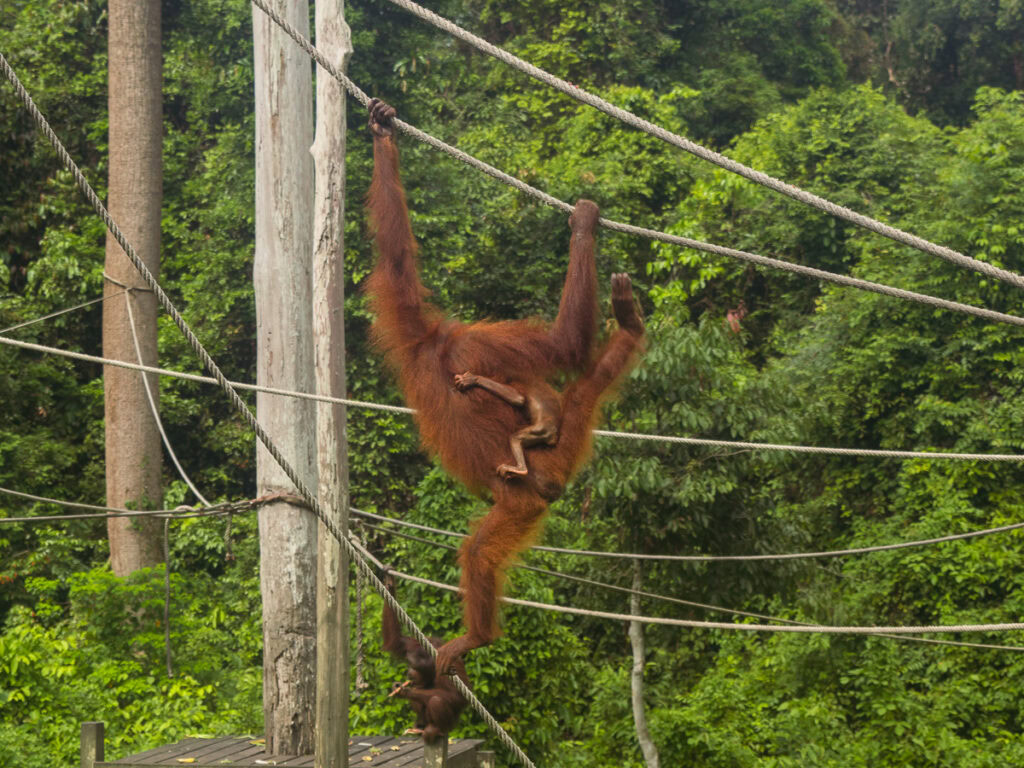
About Sepilok
Sepilok is an essential stop on this Borneo itinerary because of its conservation projects, particularly the Orangutan Rehabilitation Centre, as well as the lesser-known Borneo Sun Bear Conservation Centre (BSBCC).
Though it’s a little more clinical and organised than the wild encounters you might get in Kinabatangan River, you’ll get a much higher chance of seeing more orangutans at a closer vantage point, as well as be able to hear about the work these legendary conservations teams have been putting in for decades to protect both of these species.
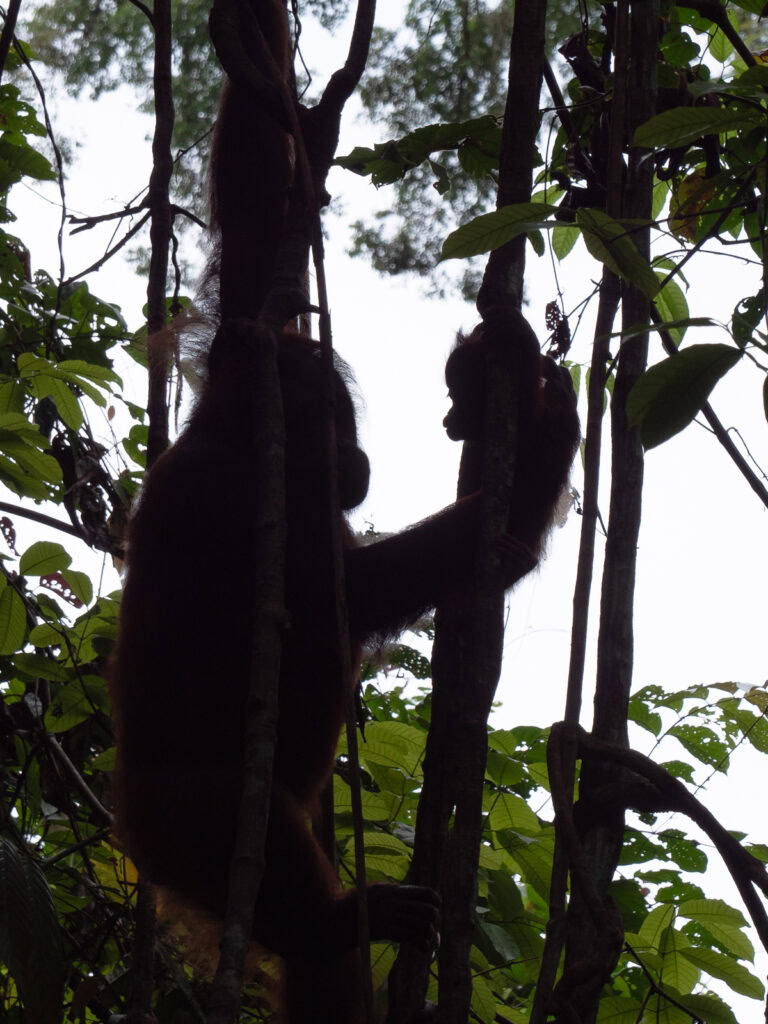
Conservation centres in Sepilok
🦧 Sepilok Orangutan Rehabilitation Centre
This was the first dedicated orangutan conservation project in the world, opened way back in 1964, and it houses and rehabilitates injured orangutans with the goal of releasing them back into the wild.
The centre backs onto a huge protected forest reserve, so once released the orangutans are free to come back to visit the centre they wish, which they often do for supplementary food at the twice-daily feedings. There’s also a nursery at the centre which raises orphaned orangutans and teaches them how to survive in the wild before being released.
One of the most memorable moments of all of my travels is watching a mama orangutan teach her baby how to climb outside the nursery, honestly one of the cutest things I’ve ever seen. Video for proof!
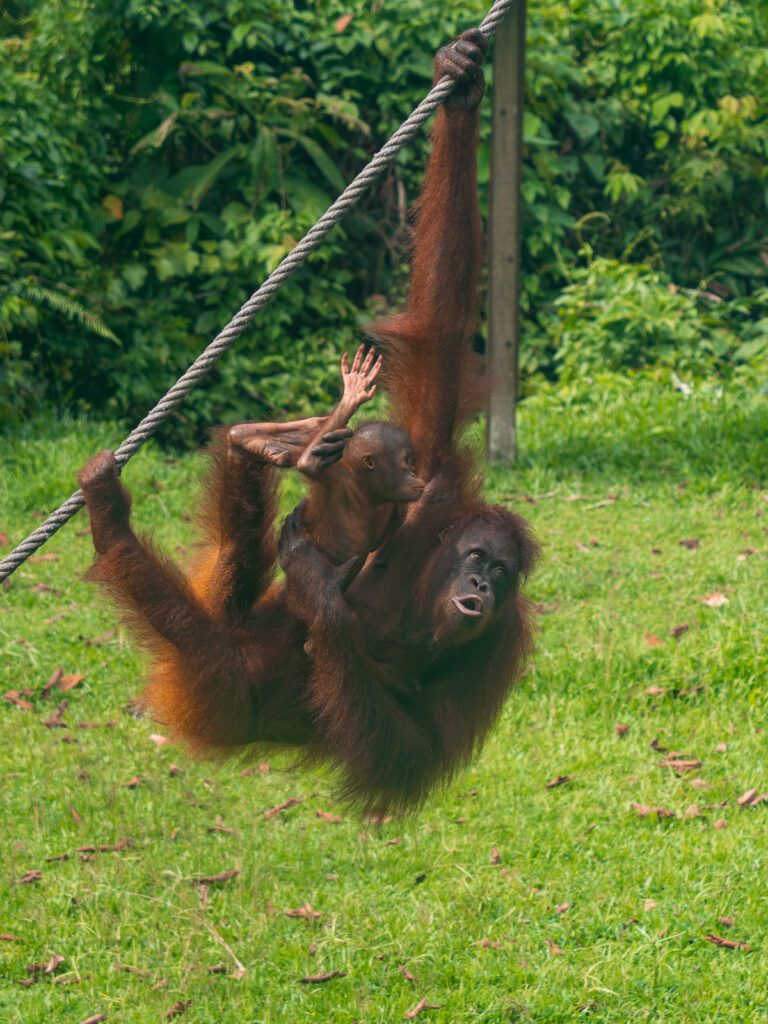
🐻 Borneo Sun Bear Conservation Centre
Right next door to the orangutans is another must-visit wildlife conservation project, the BSBCC, run by the legendary sun bear expert Dr Wong and his team of passionate biologists. You can see rescued sun bears and learn all about the species’ plight and the dangers of poaching, the illegal wildlife trade, and deforestation.
This place doesn’t get anywhere near as much attention as their orange friends next door unfortunately, but they really, really need support from tourists coming to visit so they can keep doing their amazing work to protect the world’s smallest bear.
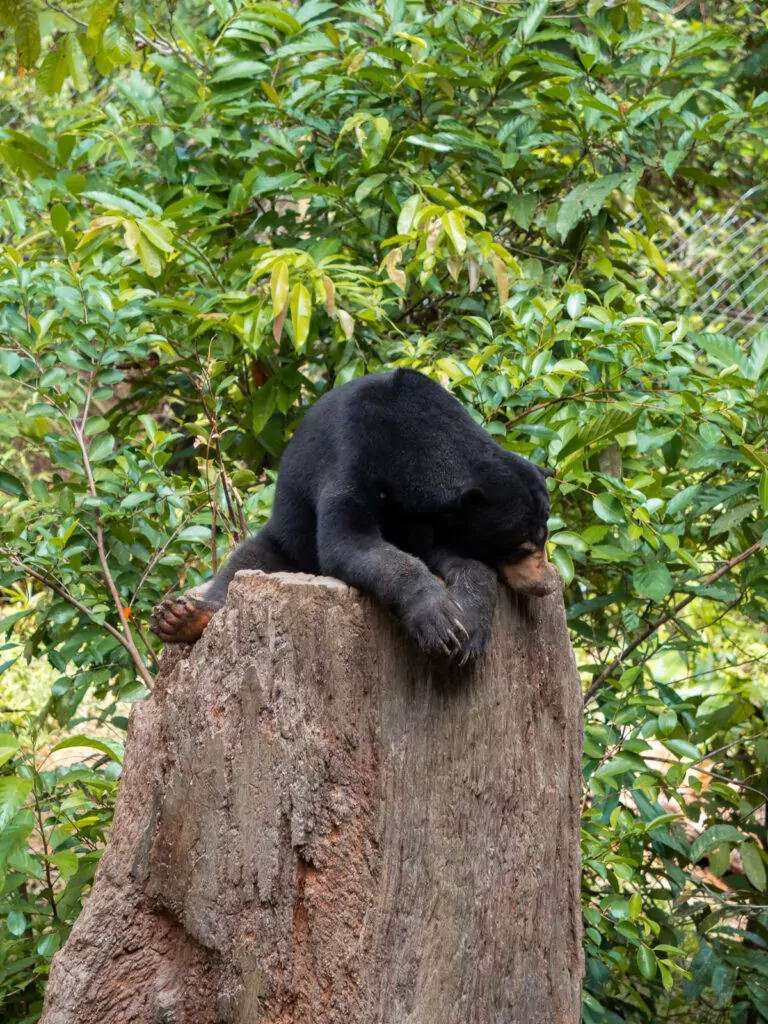
Is the Sepilok Orangutan Rehabilitation Centre ethical?
It’s so important to question if conservation projects and sanctuaries are ethical, because any organisation can slap those words on the end without having to meet any formal standards, but yes, the Sepilok Orangutan Rehabilitation Centre is ethical.
The centre is supported by respected responsible tourism organisations like Responsible Travel and G Adventures, these are my go-to resources for checking if a sanctuary or animal conservation project is legitimate.
The main goal of the centre is to rehabilitate and release the apes back into the wild, there’s no organised interaction between orangutans and customers, and though the daily feedings might be considered unnecessary for semi-wild orangutans, these feedings bring in a huge amount of visitors which directly goes towards supporting the centre’s nursery, medical centre and research projects.
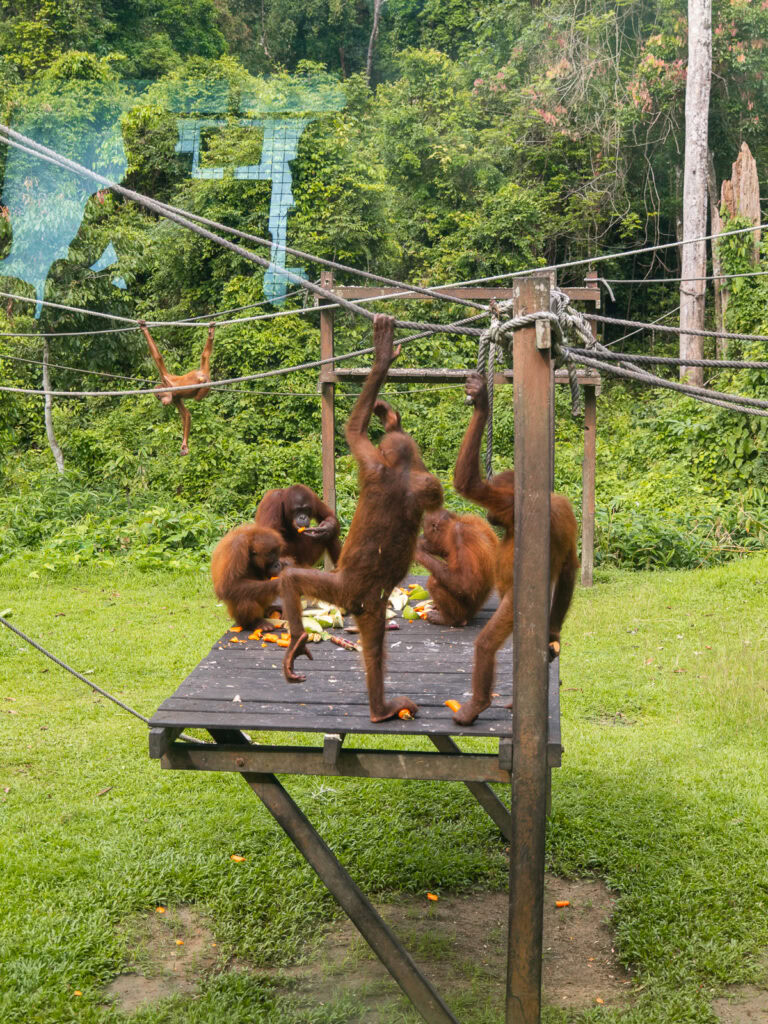
Other things to do in Sepilok
- Walk through the treetop at the Rainforest Discovery Centre
- Join a jungle trek or night walk
Where to stay in Sepilok
There are a bunch of lodges in Sepilok, and most of them offer both dorms rooms and private rooms.
- Paganakan Dii Tropical Retreat is the best-rated super cheap option
- Sepilok B&B is another budget-friendly one
- Borneo Sepilok Rainforest Resort is a bit more expensive, this is where I stayed on my tour. Beautiful setting with jungle huts amongst the gardens, swimming pool, decent restaurant.
- Sepilok Forest Edge Resort has epic glamping tents
- Sepilok Nature Lodge is known for having wild orangutans come and visit the hotel’s grounds
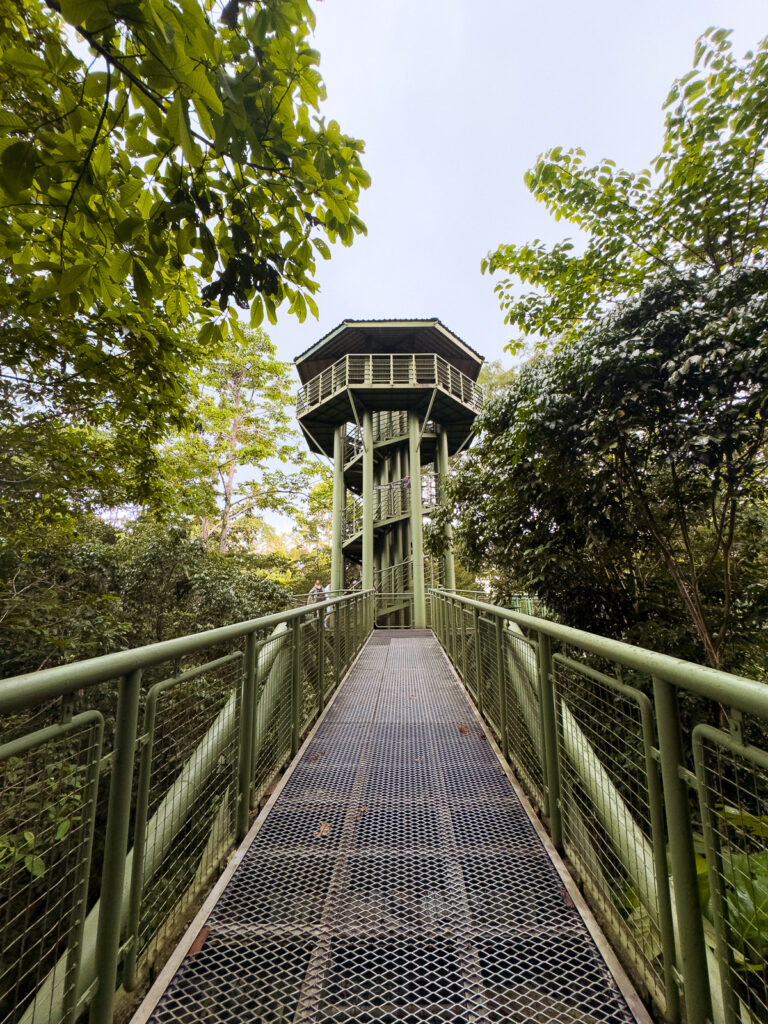
Sandakan & Turtle Islands
How to get to Sandakan: A short drive from Sepilok, or a 40 minute flight from Kota Kinabalu
How long to stay: 1-2 days if you’re also heading over to Semporna/Sipadan, maybe longer if you’re not doing that part of the coast and want more island time
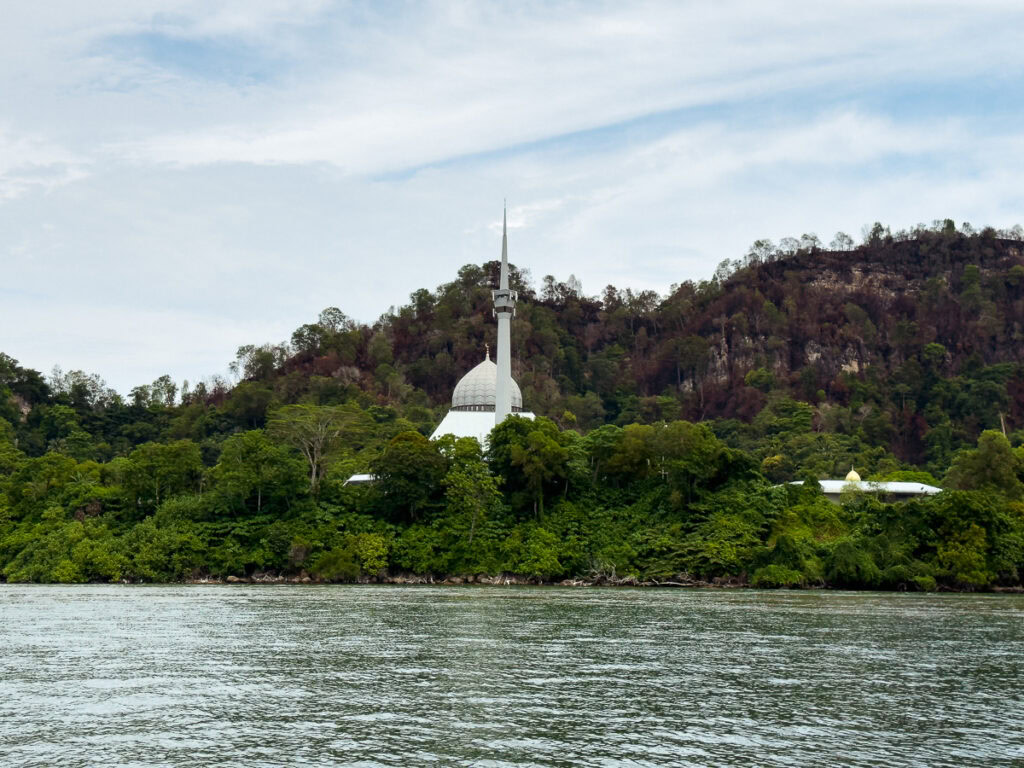
About Sandakan
Sandakan mainly serves as a transport hub for travellers who want to reach Sepilok and Kinabatangan River without the long drive from KK, but there is enough to see and do around Sandakan itself to fill a day or two.
Once the capital of British North Borneo, it’s got a dark past with a number of WWII historical sites and memorials you can visit if you’re a history buff.
And when you’re done with the mainland, jump on a boat and head out to one of the nearby islands to witness nesting turtles and maybe release some babies into the ocean.

Things to do in Sandakan
- Learn about Borneo’s significance in WWII at the Sandakan Memorial Park
- See the St Michael Church, one of the oldest stone buildings in Sabah and a survivor of WWII bombings
- Soak up the view from Puu Jih Shih Buddhist Temple
- Try local cuisine at the waterfront market
- Head out to one of the islands for a night or two, to learn about turtle conservation and see nesting turtles if you’re there at the right time of year
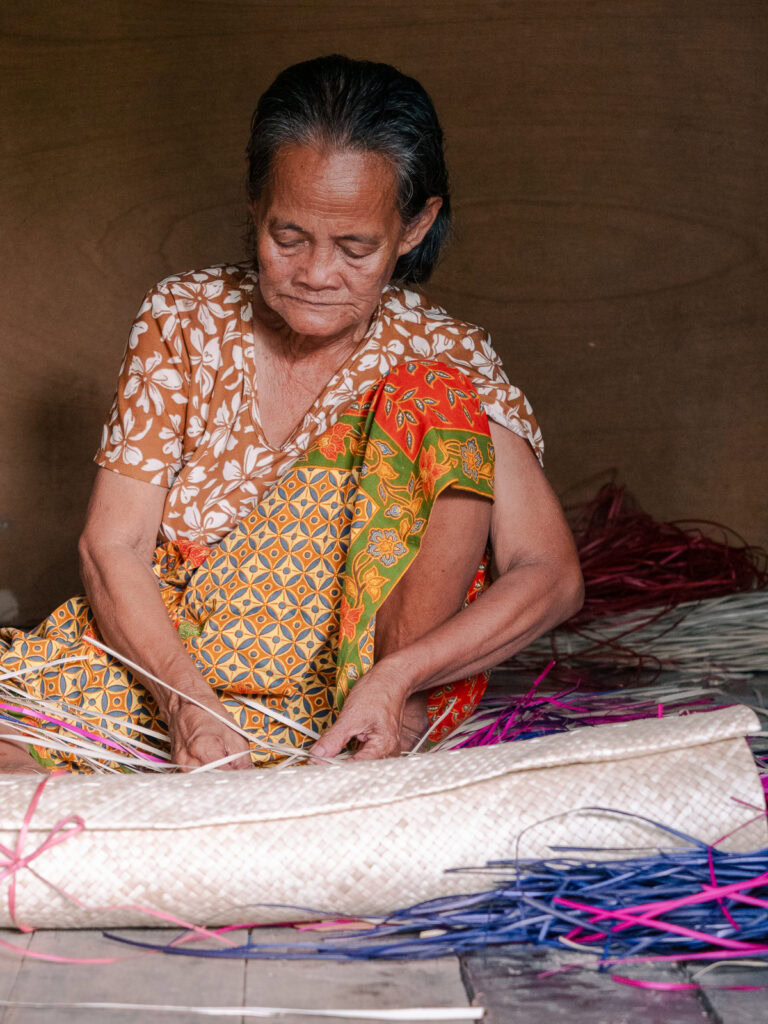
Where to stay in Sandakan
Budget:
- Sandakan Backpackers Hostel (basic but budget-friendly)
- AeCOTEL Mingle Hostel (new, affordable)
Mid-range:
- Sabah Hotel
- Homexuite Apartments
- Lots of homestays, check booking.com
Islands:
- I stayed at Walai Penyu on Libaran Island, a back-to-basics beach tent experience but so, so magical! We did a village tour, released turtles, and played Uno drinking rum under the stars.
- Selingan Turtle Island is a popular option
- Lankayan Island Dive Resort is a Maldives-style luxury island resort with overwater bungalows about 1.5h north of Sandakan, a bucket list stay!

Semporna
How to get to Semporna: From Sandakan you could catch a 6h bus which runs a few times a day, or you can fly Sandakan or KK to Tawau Airport and then catch a transfer to Semporna
How long to stay: 1-2 days for land adventures, longer if you’re diving from here
About Semporna
Semporna is a small town on Sabah’s southeastern coast, acting as the gateway to some of the best scuba diving sites in the world. The waters that surround Semporna and its islands are pure magic, playing host to a dazzling array of marine life, with excellent visibility and colourful coral reefs that are worth travelling for.
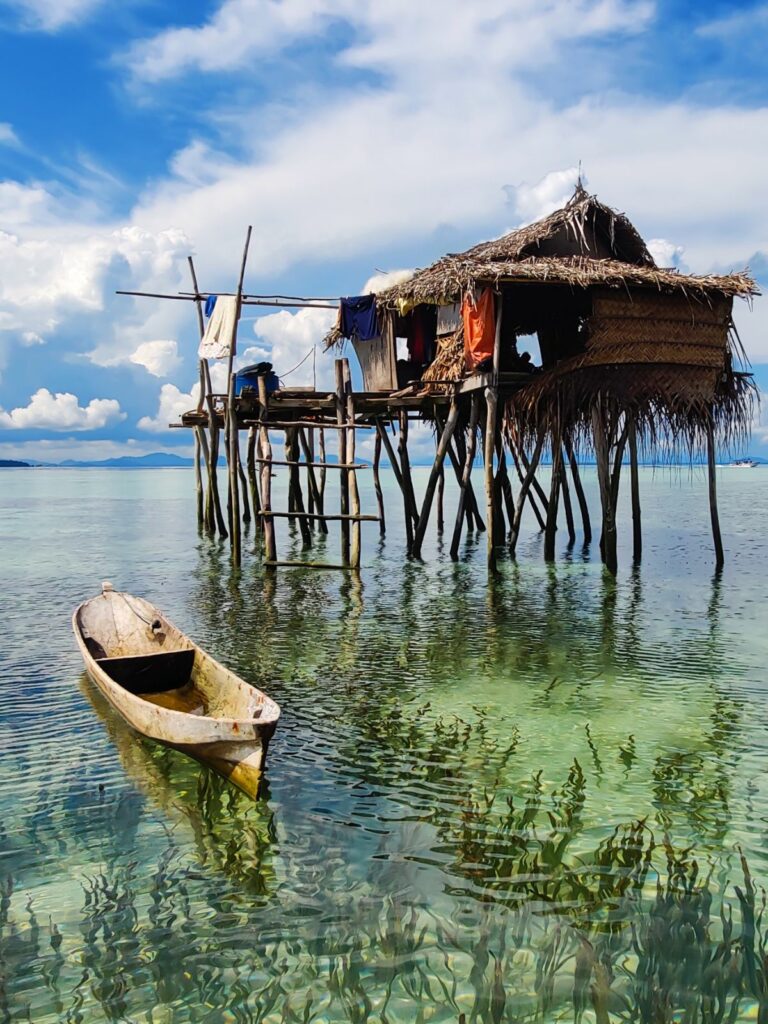
Things to do in Semporna
- Scuba dive! Whether you’re an experienced diver with loads of underwater adventures under your (weight)belt, or you’re just considering dipping your toes into the water for the first time, Semporna’s got countless sites within easy reach that’ll blow your mind and potentially set you up for total disappointment for any future dives 🙃 More specific diving suggestions in the Sipadan section below!
- Island hop around Semporna’s archipelago, this tour is top-rated and visits Timba-Timba, Pom Pom and Mataking Islands
- Hike to the top of Bohey Dulang for absolutely insane views of the islands and ocean
- Go snorkelling if you’re not keen for scuba diving
- Learn about the Bajau Laut tribe, a nomadic community known as the Sea Gypsies who live in stilted houses on the water. There used to be tours into some of the Bajau Laut villages however from what I can see they’ve been shut down since the pandemic, this kind of tourism can be really tricky to do ethically, so if you do book a tour please make sure it’s run by locals in conjunction with the Bajau Laut community itself, and that it’s not exploitative. If you’re not confident then best to learn about the tribe from afar by reading about them instead!
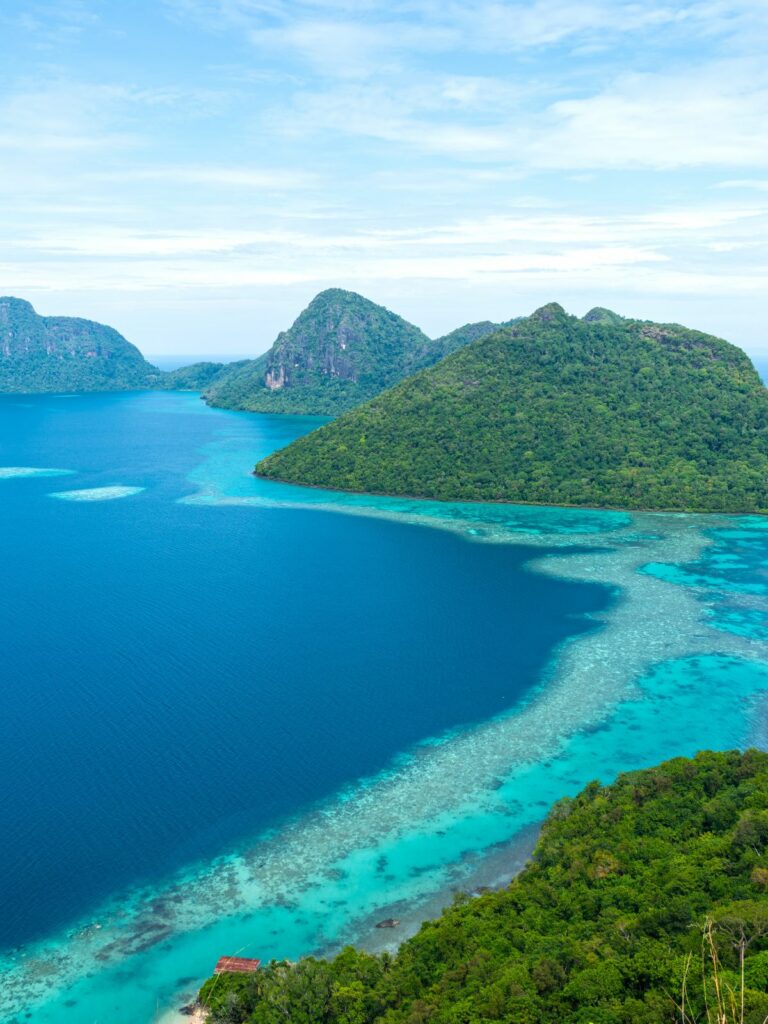
Where to stay in Semporna
Budget:
- I stayed at Bubble House, a low key, quiet homestay with dorms and private rooms. Highly recommend!
- Island Backpackers (cheap and cheerful social hostel)
- MY SPACE (capsule hostel)
Mid-range:
- Amazing Rooms (simple hotel, super central)
- Timba Timba Garden Resort (lush retreat out of town with free transport to the jetty)
Luxury:
- Sea Star Resort (4* overwater resort)
- Larapan Water Village (brand new small overwater resort, very rustic!)
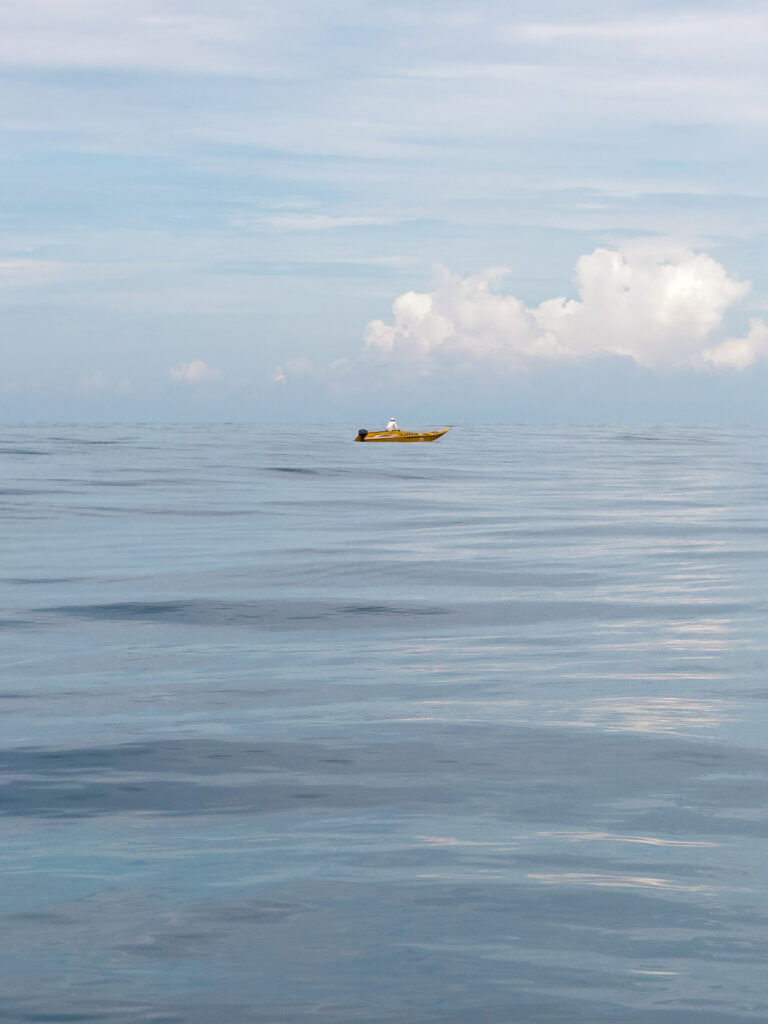
Scuba diving Sipadan
How to get to Sipadan: Stay at one of the dive resorts off the coast of Semporna, about 45m-1h by boat
How long to stay: 3-5 days
About Sipadan
Sipadan Island Park is widely regarded as one of the best scuba sites in the world, offering its visitors the chance to see rare underwater sights like barracuda tornados, schools of bumphead parrotfish, gigantic sea turtles, endless macro life, shark families patrolling the deep blue, and so much more.

How to dive at Sipadan
The conservation efforts to protect Sipadan are super strict, including a permit system that only allows 254 divers per day to experience this marine paradise.
To get your hands on a permit you need to book a Sipadan package with a local dive operator, they generally have a minimum number of days (ranging from 3-6 depending on the operator) to guarantee a day at Sipadan, and on your non-Sipadan days you’ll visit equally impressive dive spots around nearby Mabul and Kapalai Islands instead.
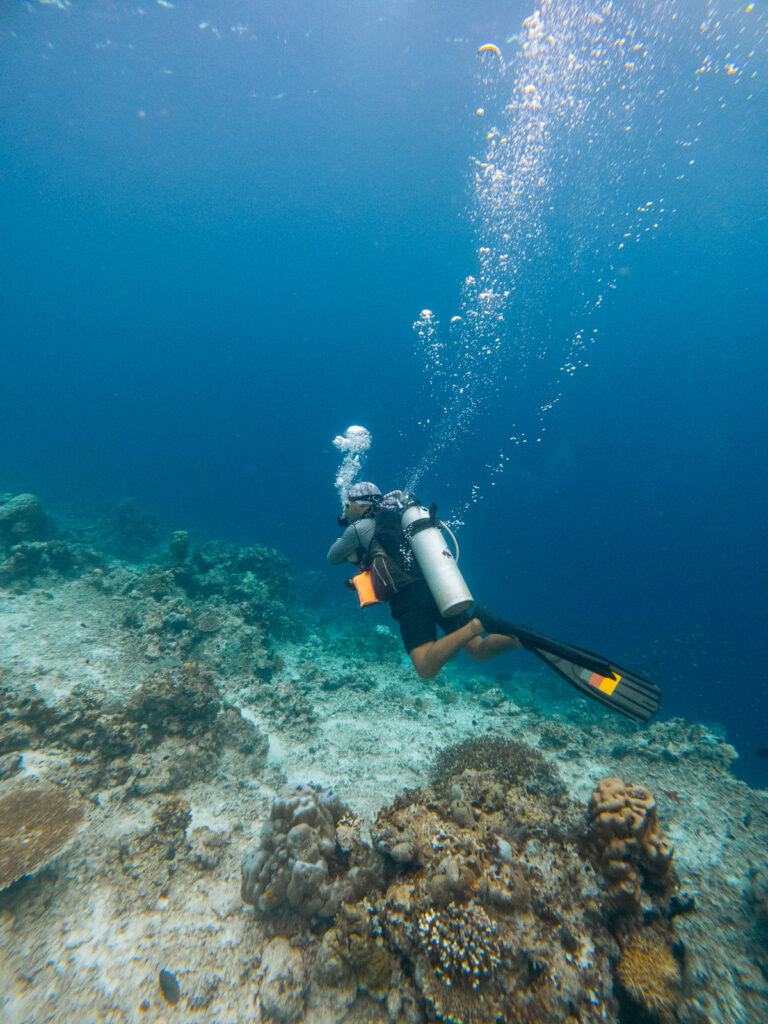
If you want to include Sipadan in your two weeks in Borneo itinerary, you’ll need to plan it in advance to make sure you can secure a Sipadan permit, because they do get booked up.
You also need your Advanced Open Water certification, this is a rule of the Sipadan Island Park and your certification will be checked on your Sipadan day before you’re allowed in the water. If you don’t have your AOW yet then don’t stress, you can do the course with your chosen dive operator at sites around Mabul and Kapalai (five dives across two days) and then you’ll be able to dive Sipadan on your 3rd or 4th day.
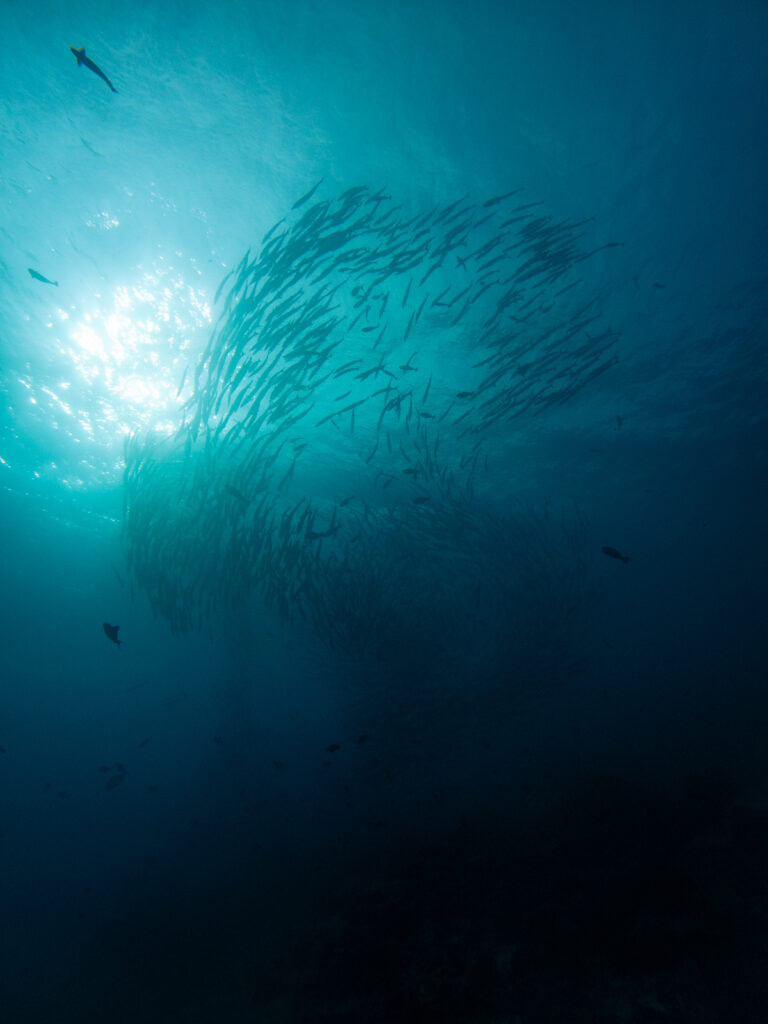
Best Sipadan experience: Seaventures Dive Rig
I’ve been very fortunate to have experienced a lottttt of cool stuff around the world thanks to my job, but spending five days on the world’s only dive rig is up there as one of my all-time favourite travel experiences.
Seaventures Dive Rig near Sipadan is a world-first dive platform, it’s an ex-oil rig that’s permanently located right next to Mabul Island, and it’s been transformed into an eco-friendly dive experience with comfortable cabins, delicious food and a PADI 5-star dive centre.
Insane, right?!
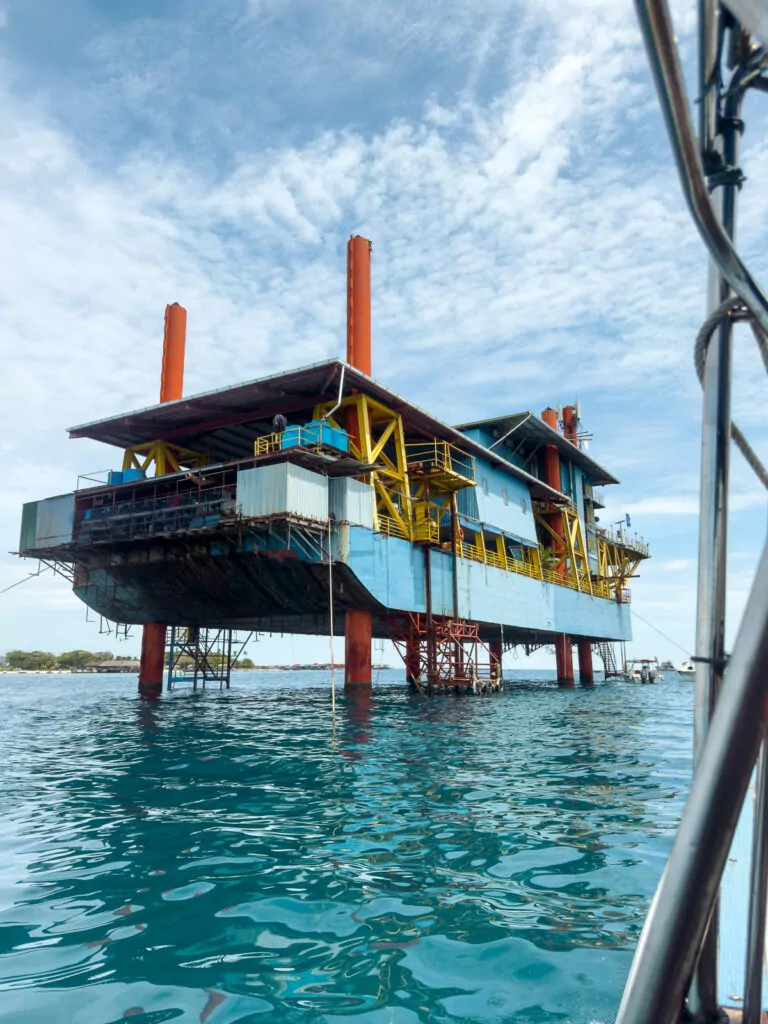
You can read my full review of the rig here or watch my TikTok video about it, but basically you just eat, sleep, dive and repeat, with three boat dives per day included in your stay, plus unlimited house reef dives of the marine neighbourhood that lives directly underneath the rig. Absolutely wild.
I genuinely can’t recommend this place enough, the dive centre team are all total legends, the cabins are really comfy, the people you meet are all like-minded dive-obsessed travellers, even the food exceeded all my expectations.
You also get a Sipadan day guaranteed with a three night stay or two guaranteed with a five night stay, compared to some of the dive resorts that require five nights just for a single Sipadan day!
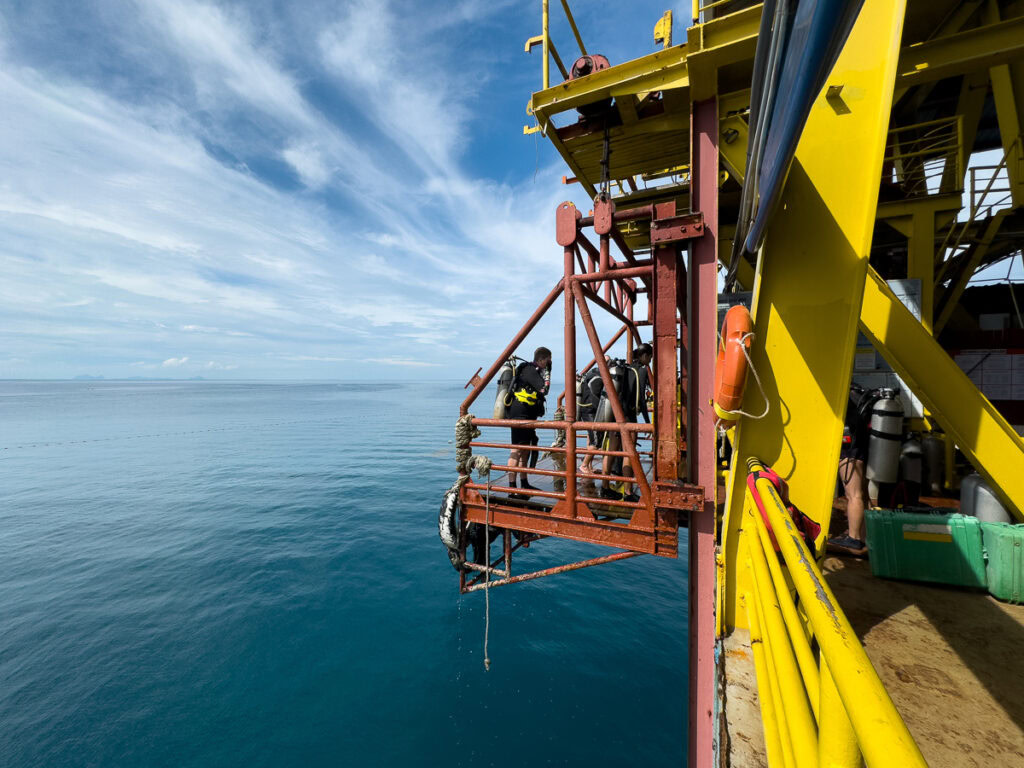
Other dive resorts
If Seaventures is fully booked, there are other options for booking a Sipadan package with local diver operator, like:
- Mabul Water Bungalows (5N minimum stay for Sipadan)
- Scuba Junkie Borneo (Sipadan package options from 2N)
- Sipadan Water Village (4N minimum for Sipadan)
- Borneo Divers Mabul (4N minimum for Sipadan)
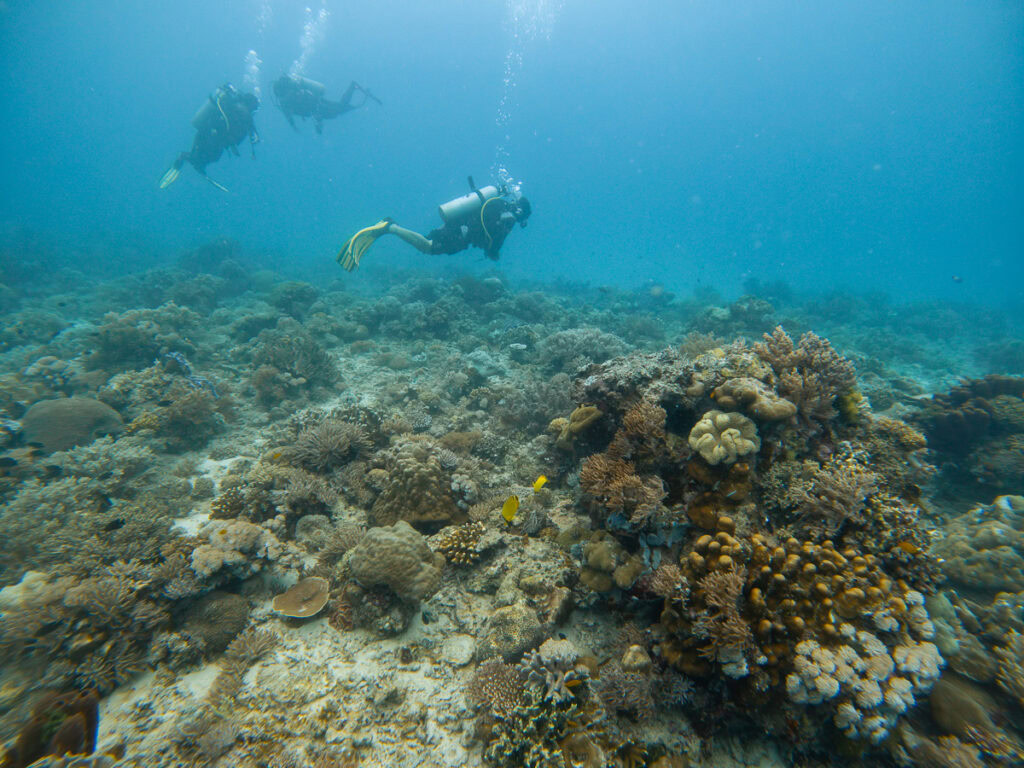
Other places to add to your Borneo itinerary
Danum Valley, Sabah
If you’re a hardcore wildlife enthusiast or photographer, the unspoilt, ancient rainforests of Danum Valley offer less commercialised nature experiences.
It’s more remote than Kinabatangan River which means less tourists and higher chances of seeing rare animals like pygmy elephants, sun bears and even the elusive Bornean clouded leopard, but it takes time to get there and will set you back a pretty penny.
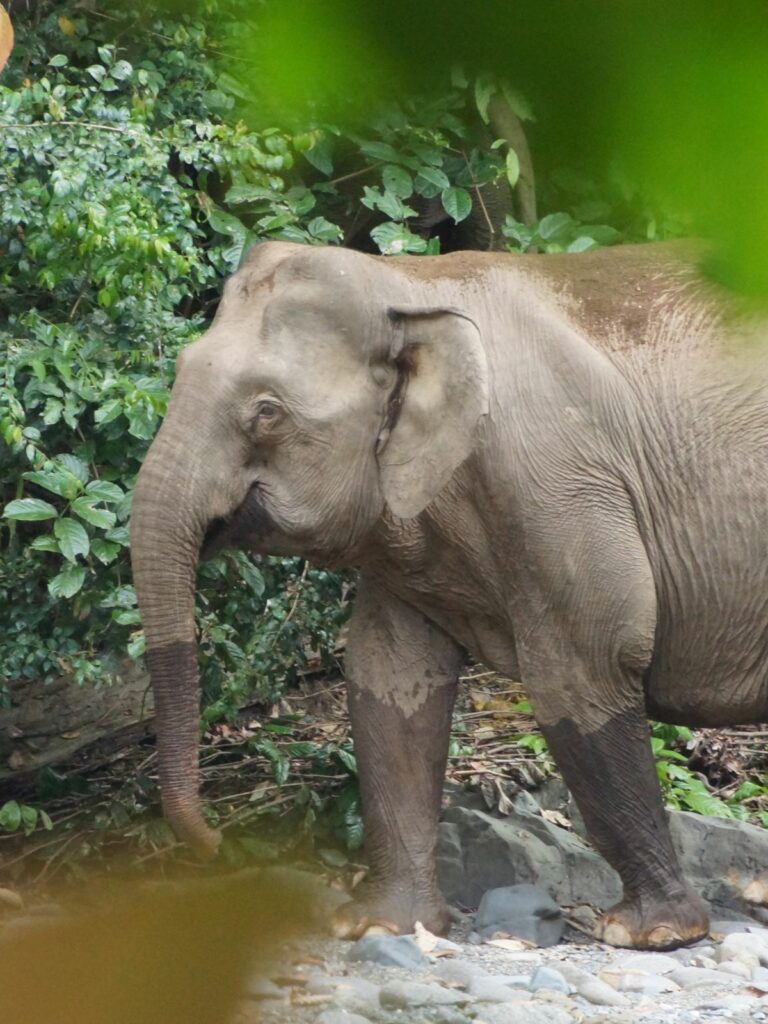
Gunung Mulu National Park, Sarawak
One of the most unique landscapes in the whole of Southeast Asia, Gunung Mulu National Park is famous for its spectacular limestone karsts that jut out dramatically through the dense rainforest, very Avatar-esque!
Adventure seekers with extra time up their sleeve could add this onto their itinerary, or if you prefer land-based activities rather than being underwater then you could swap out Semporna/Sipadan and come here during their two week Borneo trip instead.
The park’s nearest airport is Mulu, you can fly there from Kota Kinabalu and then book a tour to explore the caves and karsts.
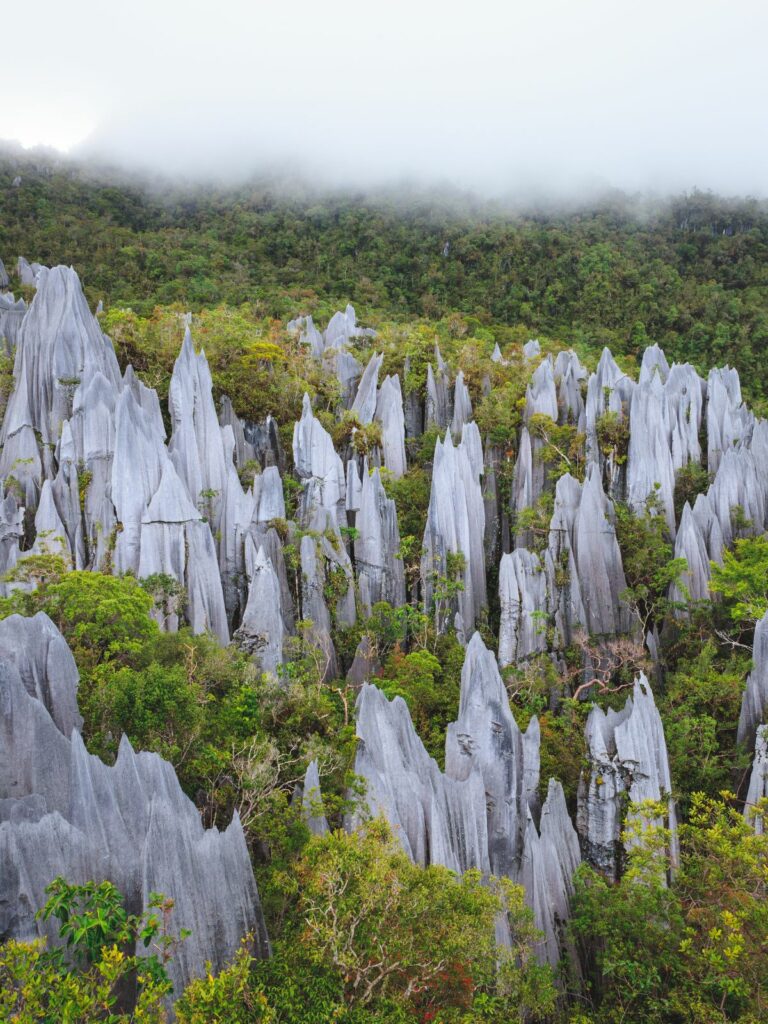
Kuching, Sarawak
Kuching is the capital of Sarawak, Malaysian Borneo’s southern state, and a hot spot for culture, cuisine and colonial history.
If you’re wanting to split your Malaysian Borneo itinerary between the two states then definitely set aside a couple of days to enjoy Kuching’s charm, and don’t miss a Sarawak river cruise, food tour and the Sarawak Cultural Village.

Bako National Park, Sarawak
Just 45 minutes from Kuching by bus/taxi and boat, Bako National Park is one of Sarawak’s premier wildlife spotting locations.
The mix of landscapes means it’s got a diverse local population, from the probiscis monkeys and langurs leaping between branches, to bearded pigs rummaging around the undergrowth, to the adorable slow loris that looks like a soft toy.
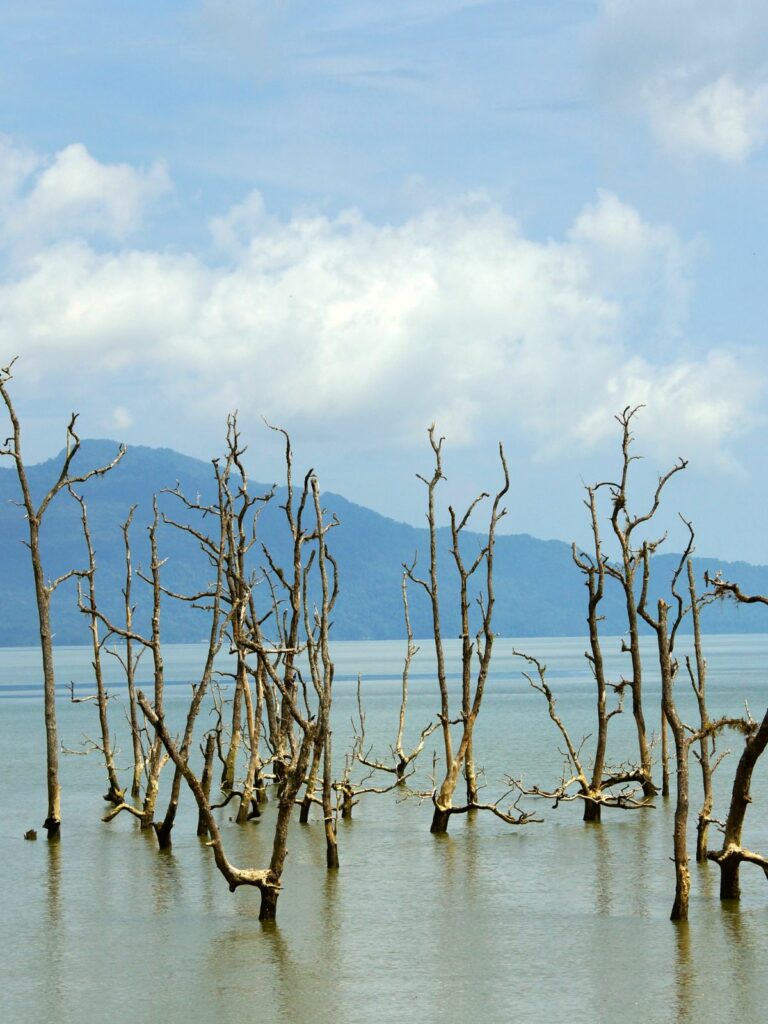
Brunei
This teeny coastal country that’s flanked by Malaysian Borneo on all sides is one of the richest countries in the world, with super clean streets, grand Islamic architecture and a conservative but laidback vibe, plus access to its own untouched rainforests.
You can fly from KK or catch a bus that takes just over 7h.
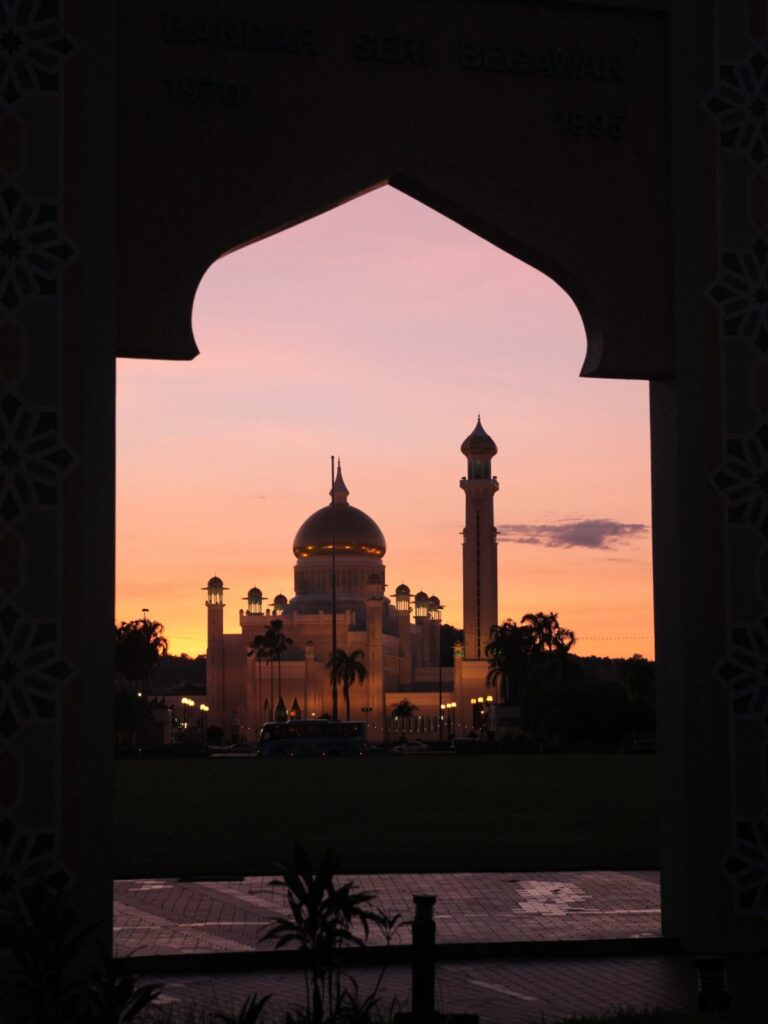
Indonesian Borneo
The Indonesian side of Borneo is much less developed than its northern counterpart, though that makes it all the more rewarding when you manage to plan an epic trip there. The lack of infrastructure does mean it’s time-consuming, costly and stressful to get around, but if you’re up for an adventure then it’s certainly that!
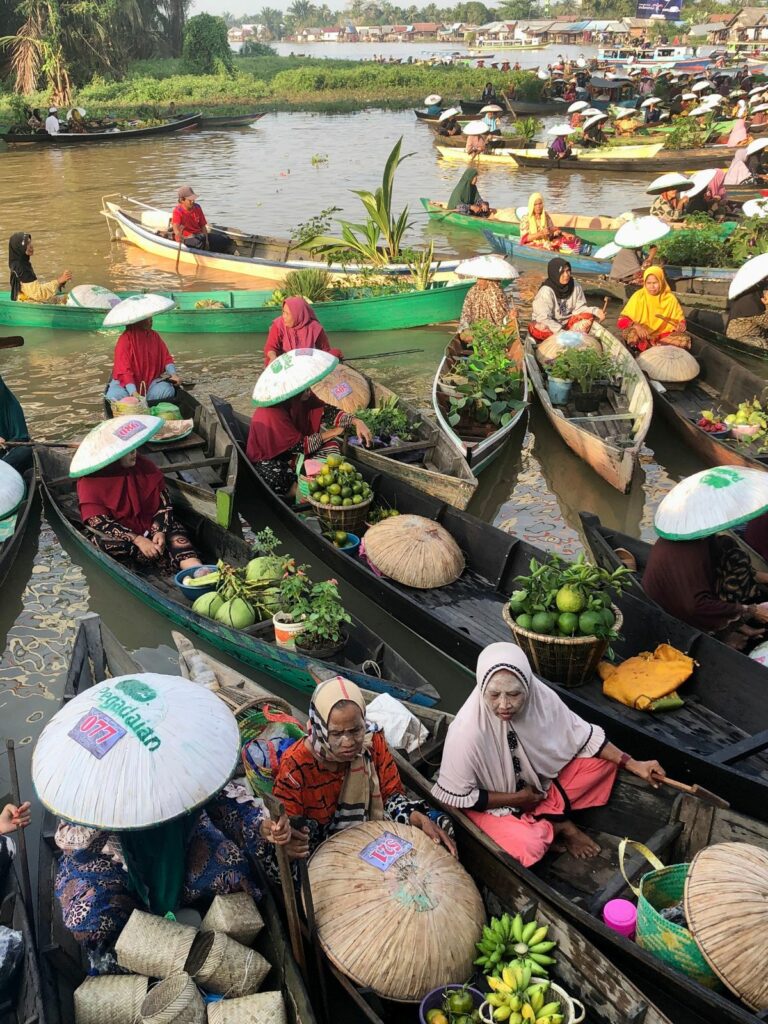
You can trek for days to find orangutans and other endangered animals, take boat after boat after boat to reach otherworldly scuba dive sites, and learn about cultures you’ve never heard of, visiting a part of the world that hardly any travellers ever get to see.
The Indonesian government is (controversially) currently building a new capital city in East Kalimantan, called Nusantara, to replace Jakarta due to overpopulation, pollution and the risk of rising sea levels, so it’s hard to know what the future of Kalimantan looks like. If it’s on your bucket list, get there soon!
Sabah/Borneo itinerary FAQs
Is two weeks in Borneo enough time?
Two weeks is enough time to see the main highlights in Sabah and maybe some in Sarawak if you don’t mind a fast-paced trip, but like most destinations, you could absolutely stay longer and still find things to do!
By following this two week Sabah itinerary you can split your time between jungle tours, river safaris, conservation projects, scuba diving/snorkelling, visit a tropical island or two, and still go home feeling refreshed.
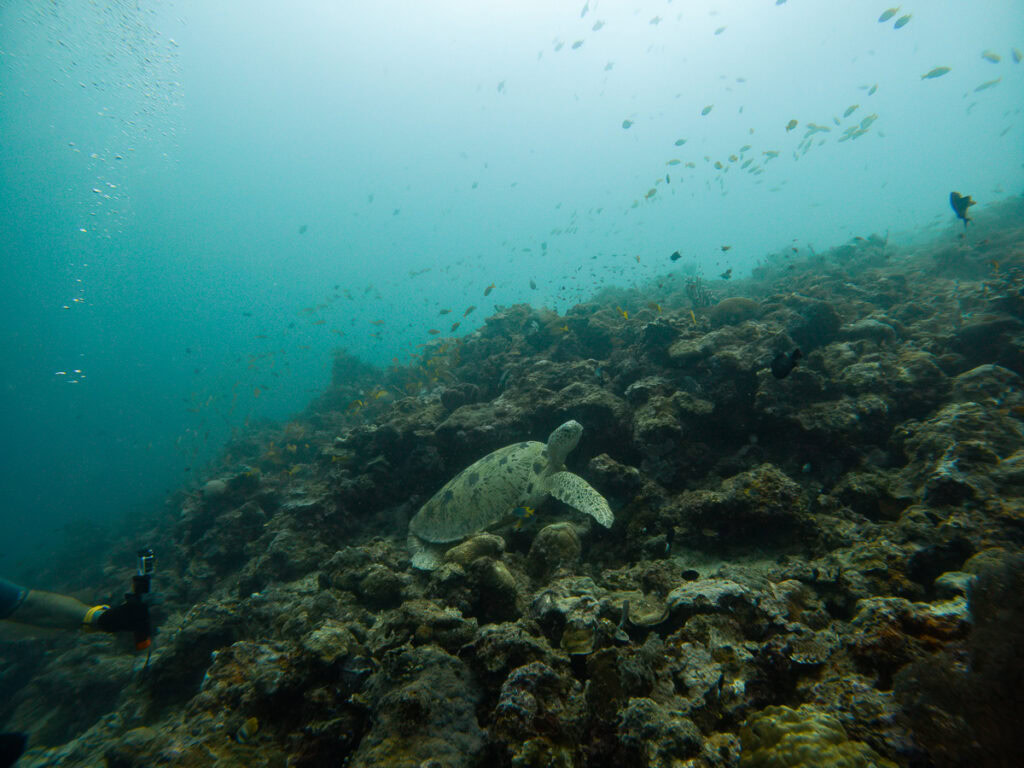
Is Sabah safe for solo female travellers?
Sabah is generally considered safe for solo female travellers, and I had no safety concerns during my time there, however there are a couple of things to be aware of:
- Malaysia is an Islamic country with a conservative culture, so it’s important to dress and act appropriately to avoid any unwanted attention. I found Borneo to be less conservative than Peninsular Malaysia, especially in Kota Kinabalu where both tourists and locals wear typical Western-style hot weather clothing, but in less developed areas and smaller villages it’s respectful to dress modestly.
- Borneo’s nature ain’t no joke, the biggest risk here is probably something going wrong when you’re out exploring the jungles, rivers or reefs. Book reputable tours with expert local guides (like the G Adventures tour I did), be prepared for changing weather conditions, and know your limits before taking part in any treks, dives or other outdoor adventure.
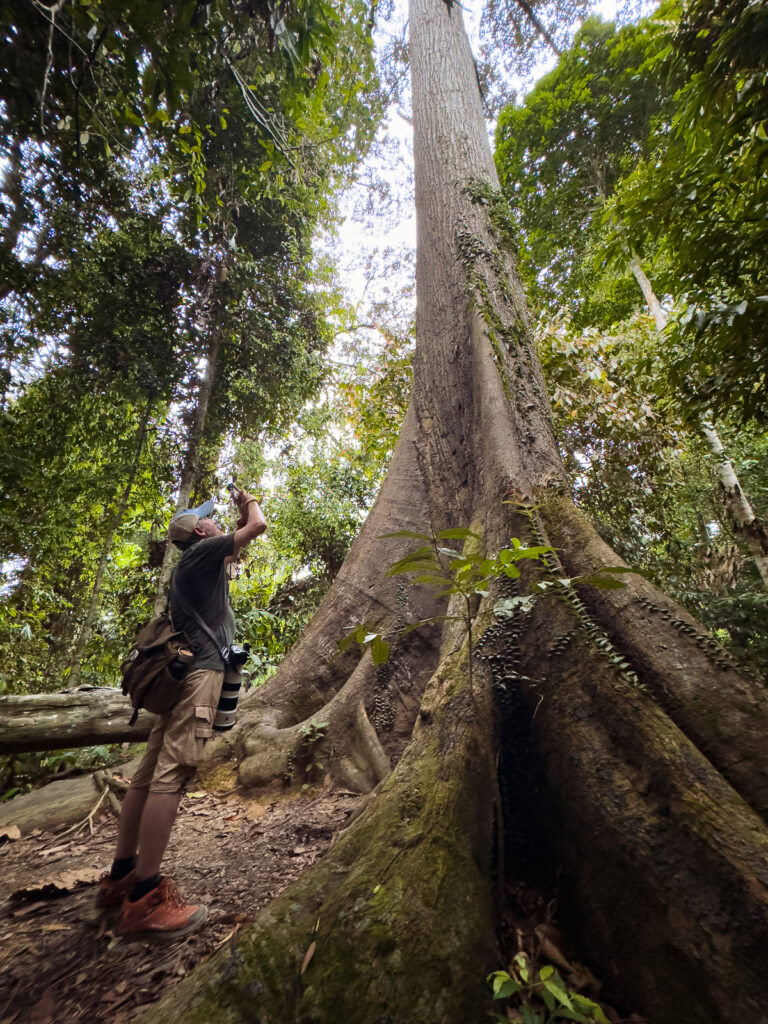
- Some of Sabah’s coast, particularly Semporna and to a lesser extent Sandakan, have had security issues due to piracy from extremist groups in the Philippines in past years, with some kidnappings from tourist resorts for ransom. At the time of writing (September 2024), the most recent incident was back in 2016. Since then, local authorities have implemented a range of security measures, including extensive surveillance of the marine border and constant patrols around the dive resorts, and after doing my own research of the situation, I personally felt comfortable visiting Semporna and Sipadan.
- One annoying consequence of these past issues is that some of Sabah’s coast has official ‘avoid non-essential travel’ warnings from major Western countries, notably New Zealand, Australia and the UK. The USA no longer has a travel warning here, and they’re generally pretty conservative about their warnings (especially for Islamic countries), so that leads me to believe that the other government warnings for Sabah are more of a bureaucracy issue rather than genuine safety concerns. Travel warnings like these can impact the validity of your travel insurance policy and can also limit your embassy from being able to provide support to you if anything does go wrong, so you just have to look into how this affects you and make your decision from there.
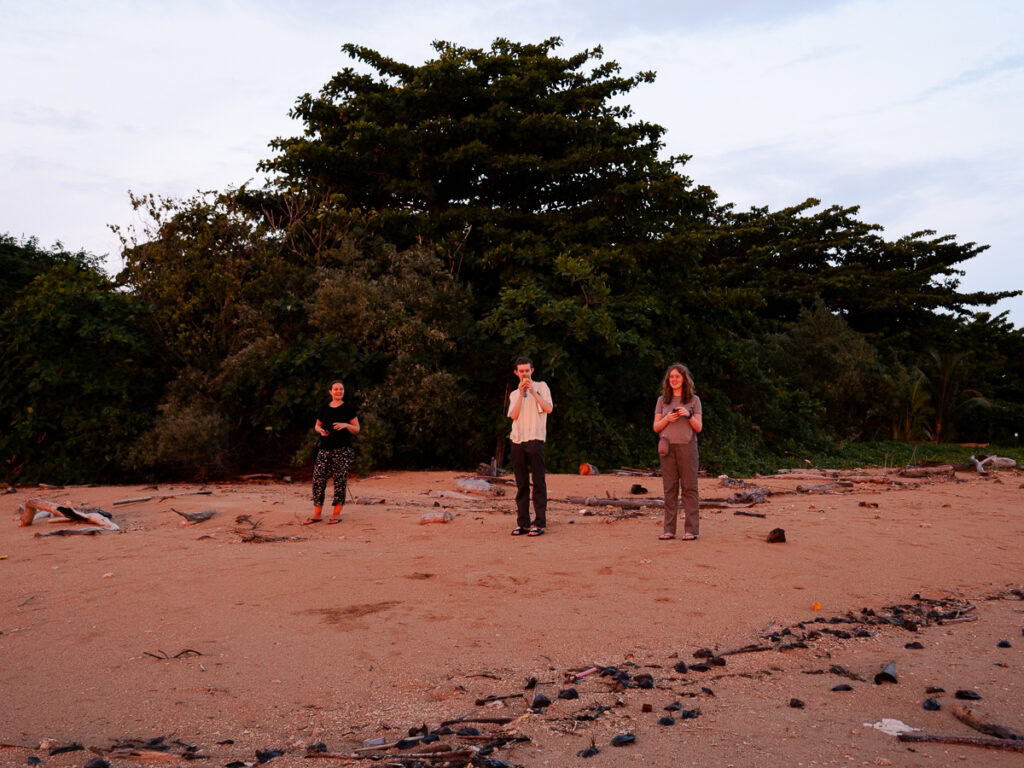
What would you suggest for one week in Sabah?
If you’ve only got one week in Sabah, I’d recommend sticking to the following:
- Day 1: Fly into Sandakan, head to Sepilok
- Day 2: Sepilok
- Day 3: Sepilok to Kinabatangan River
- Day 4: Kinabatangan River
- Day 5: Kinabatangan River back to Sandakan and fly to Kota Kinabalu
- Day 6: Tunku Abdul Rahman day trip
- Day 7: Depart from Kota Kinabalu
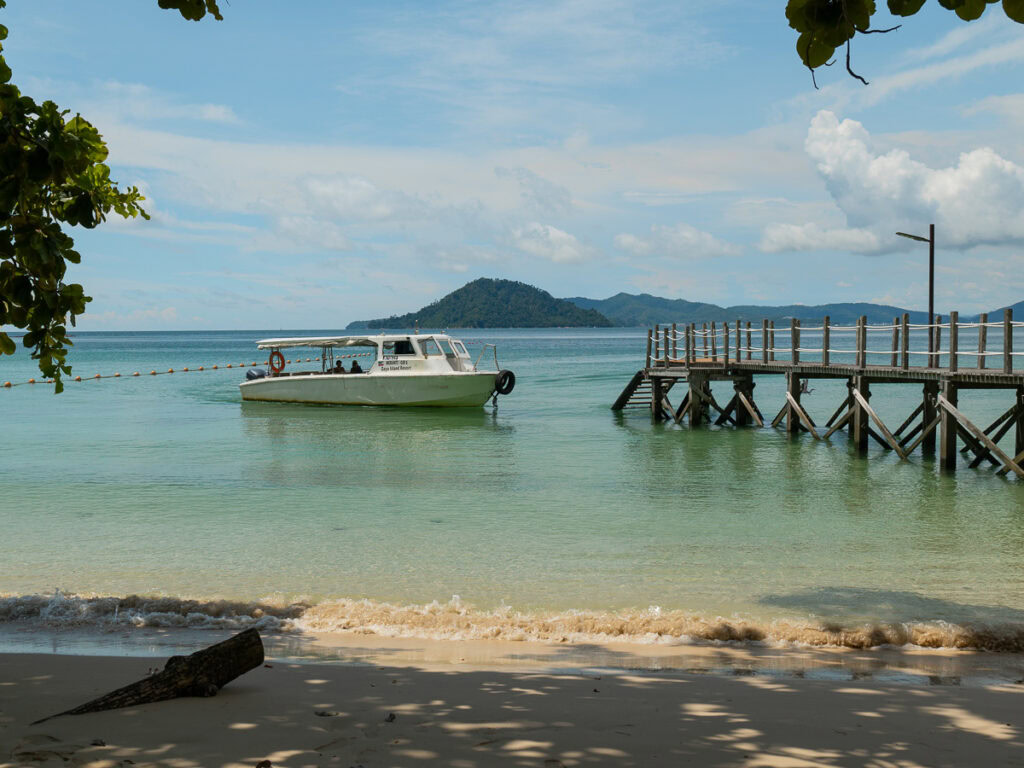
If you’ve got a week in Borneo and are desperate to dive Sipadan as well as tick the jungle wildlife boxes, you’re going to be very pressed for time but it is possible.
- Fly into Sandakan and do a 3D2N Sepilok and Kinabatangan River tour
- Come back to Sandakan to fly to Tawau
- Book a dive package with Seaventures (4D3N gets you one guaranteed Sipadan day) or Scuba Junkie (they have Sipadan options from 3D2N)
- Just keep in mind that you need a 24 hour surface interval between your last dive and your departure flight
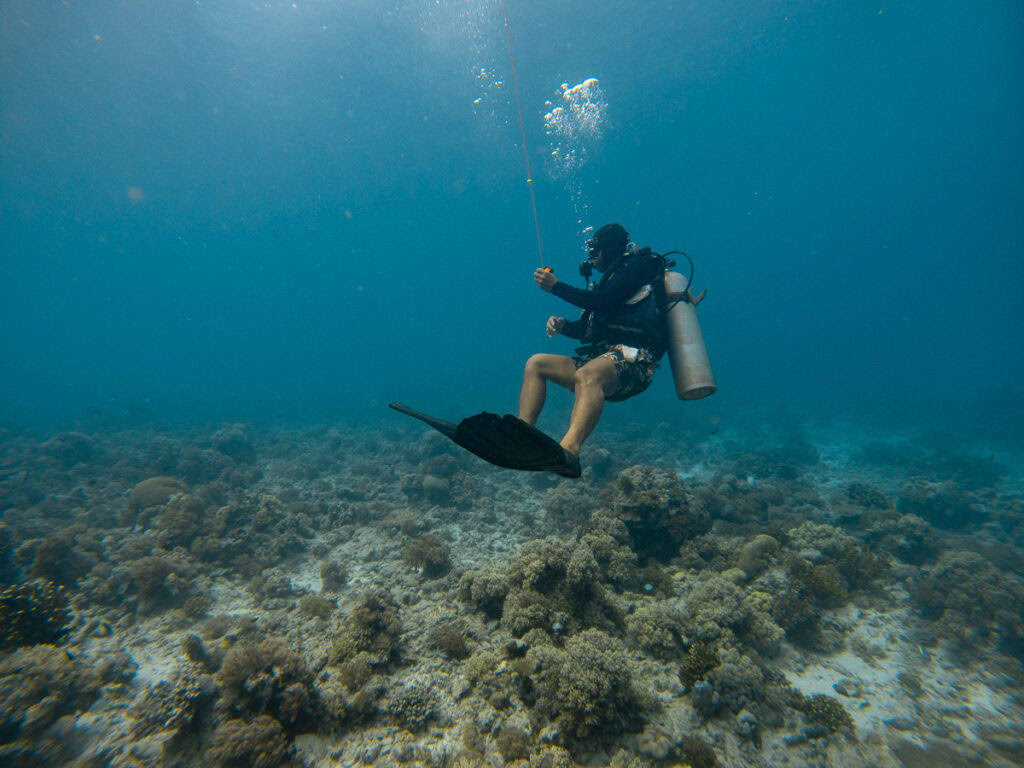
What should I pack for this Borneo itinerary?
- Lightweight, breathable clothing that’s easy to wash and quick to dry
- Long-sleeved tops and pants for jungle treks
- Raincoat
- Swimwear
- Sturdy walking shoes that can withstand mud if you’re planning any jungle walks
- Sandals or water shoes
- Comfortable day pack
- Drink bottle
- Dry bag for any island visits or dive trips
- High SPF sunblock
- Insect repellent
- Basic first aid kit
- Your PADI certification card (or the digital card in the app) if you want to dive
- Anything else you might need over a two week period, outside of Kota Kinabalu there’s not many shopping opportunities if you’ve forgotten anything, so carefully run through your packing list before you go

There you go, that’s all you need to know to plan an epic two week itinerary for Sabah in Malaysian Borneo!
If you have any questions about this Sabah itinerary or my time in Malaysian Borneo, please let me know in the comments and I’ll get back to you as soon as I can.
Have fun planning your trip, and have the best time when you get there!
OTHER MALAYSIA TRAVEL GUIDES & ITINERARIES:
- 3 weeks in Malaysia: The perfect Malaysia itinerary
- Bucket list dive experience: Seaventures Dive Rig
- G Adventures Borneo: The best wildlife tour in Borneo
- The ultimate guide to solo travel in Kuala Lumpur
MY GO-TO TRAVEL PLANNING RESOURCES
Flights ✈️ I use Skyscanner to find the best flights for my trip and then I’ll always book direct with the airline to protect myself from having to deal with dodgy third parties if anything goes wrong.
Trains 🚂 If I’m travelling through Europe, I try to travel by train wherever possible! For an extended trip (2+ weeks) I’ll calculate if a Eurail Pass is worth it, or I’ll book point-to-point tickets through RailEurope or the local train operator.
Accommodation 🛎️ I book almost all of my accommodation through booking.com, they have a user-friendly website + app and many of their options are free cancellation, easily cancelled with a simple click of a button.
Activities 🗽I use GetYourGuide, Klook and Viator to look for activities in the places I visit, or I just Google ‘things to do in [city]’! P.S. If you book anything on Klook you can use the promocode FINDINGALEXXKLOOK to get 10% off
Travel cards 💳 I’m a Wise gal through and through, they’ve been my chosen travel card for more than five years now. You can easily top up your card from your bank account or through Apple Pay, convert your money to local currency, and spend money with minimal fees and the best exchange rates around.
Travel insurance 🩺 I use Cover-More NZ travel insurance for my own trips, I have a comprehensive policy and I’ve only had good experiences with them. Cover-More also has an Australian company, but if you’re from elsewhere then two popular insurance options for global travellers are SafetyWing (cheaper policy, lower coverage) and World Nomads (more expensive but significantly better coverage).
Luggage 💼 I travel with Samsonite Cosmolite suitcases, one 75cm check in bag and a 55cm carry on bag, and I absolutely adore them and will never travel with anything else! They are SUPER lightweight (2.8kg and 1.9kg respectively) so I have much more space for my actual stuff.
Camera gear 📸 I use a iPhone 15 Pro Max for phone photos/videos, and my camera kit includes a Lumix S9 (incredible lightweight full-frame camera, a game changer for travel creators!) with a 20-60mm lens, a Lumix G9 with an 8-18mm and 12-60mm lens, a DJI Mini 3 Pro drone and a GoPro Hero 10. I do all my writing and editing on my ASUS Zenbook 14, it’s lightweight but powerful enough for photo editing and intense blogging sessions.
